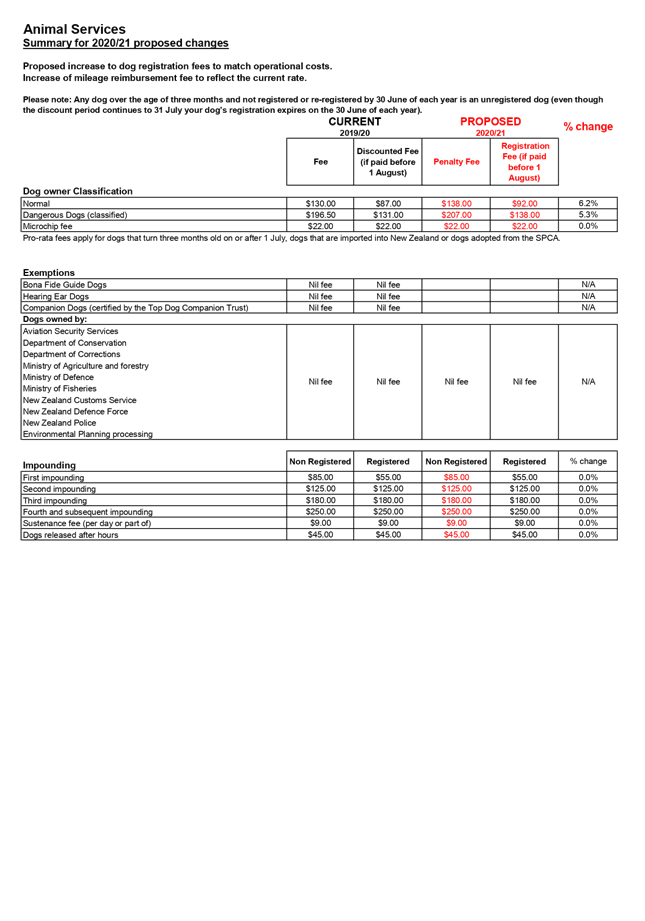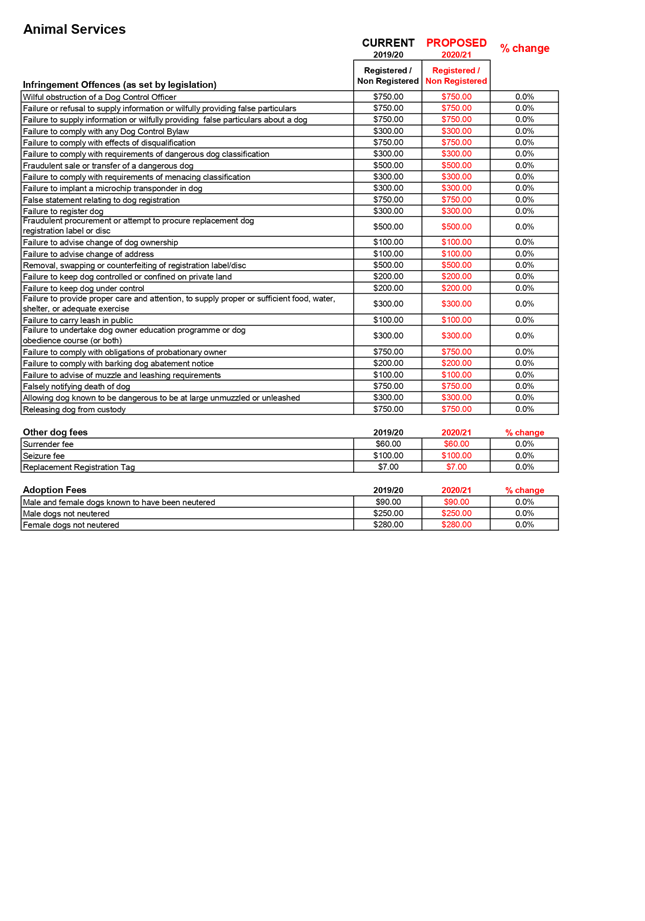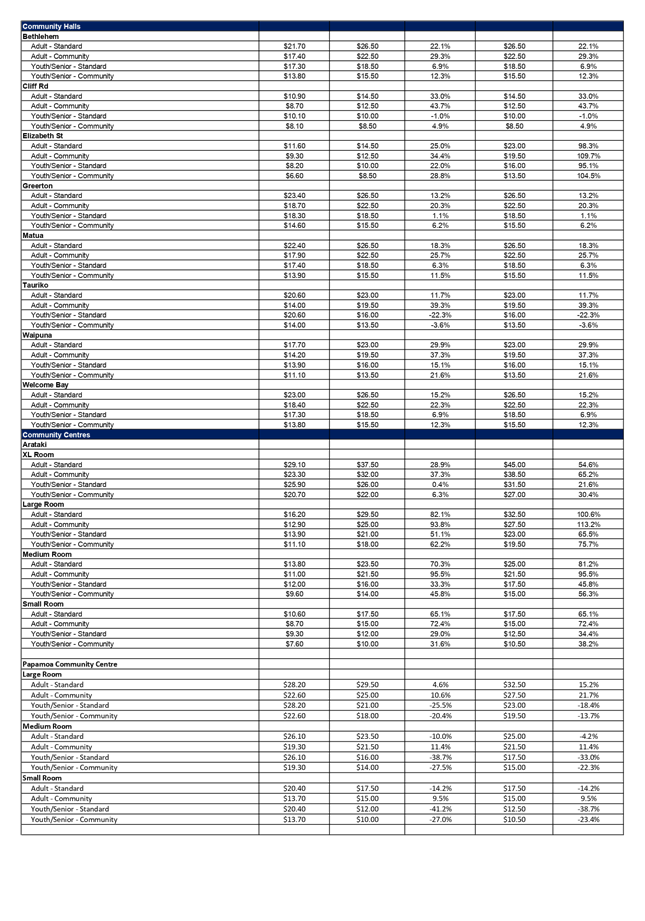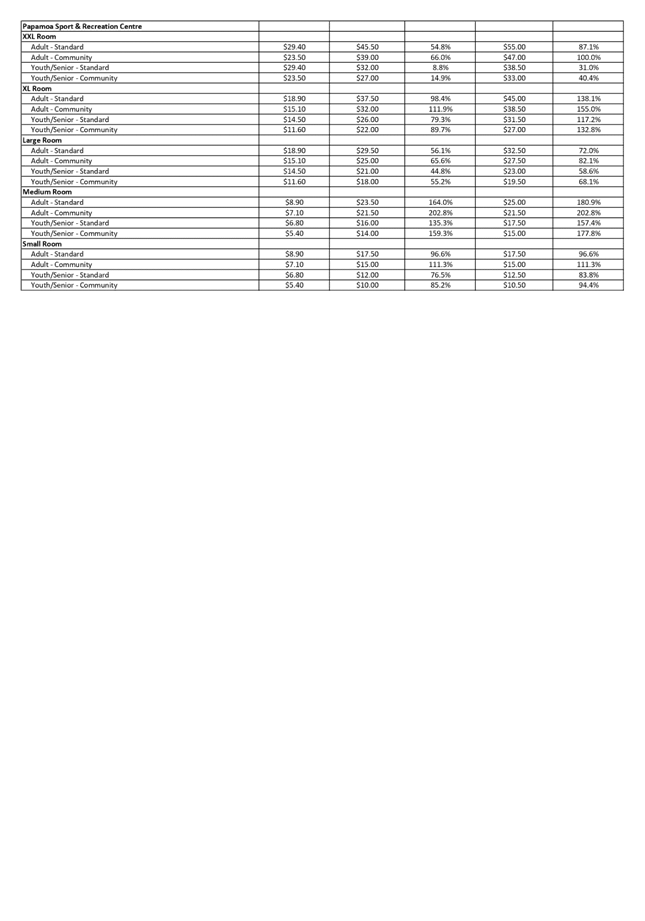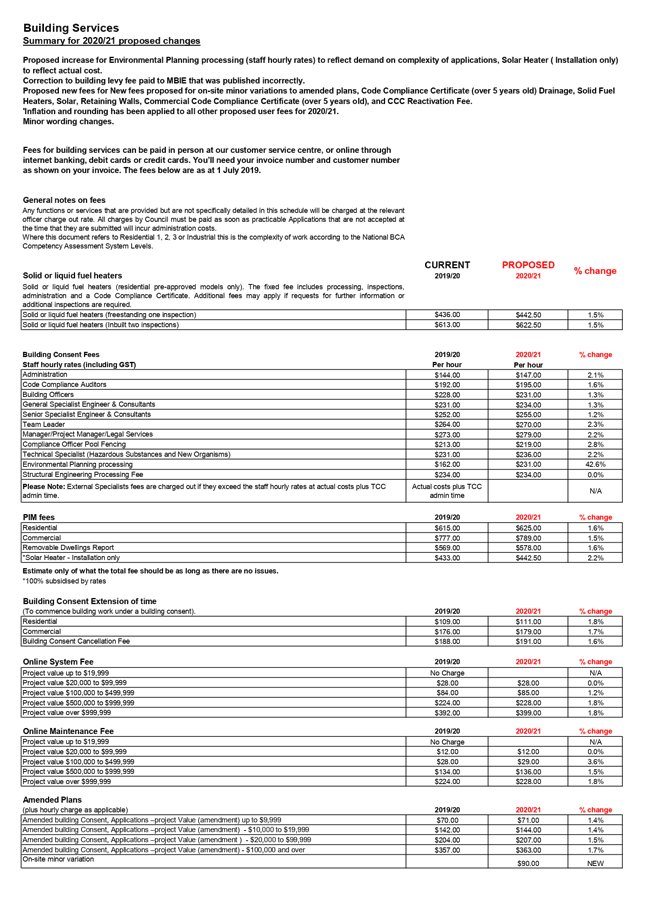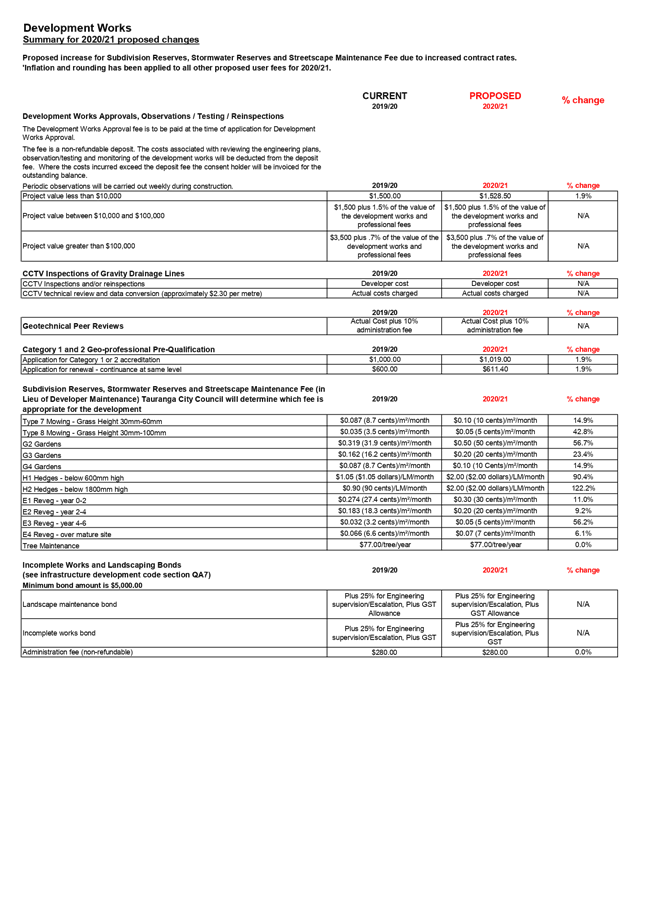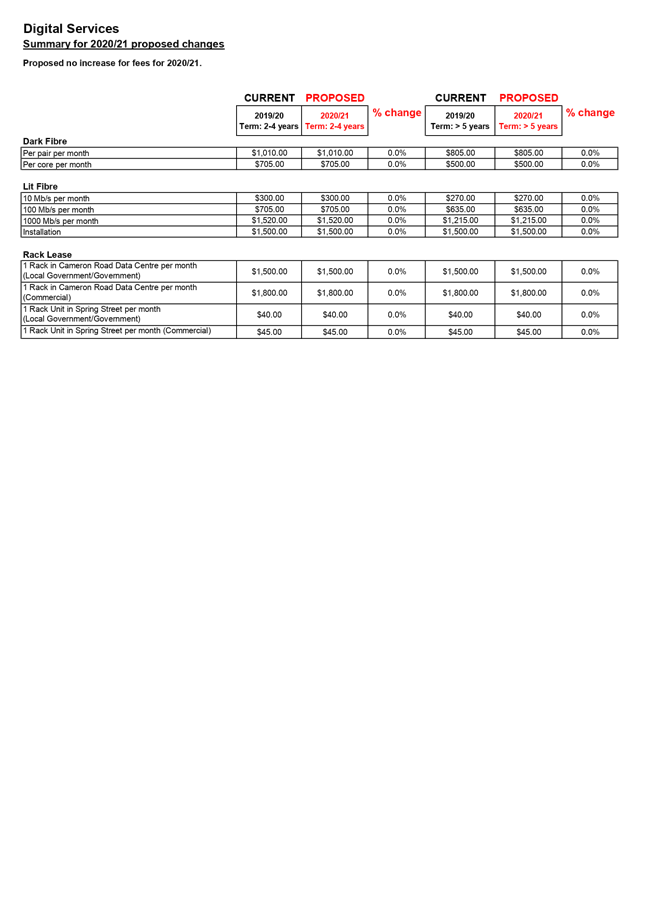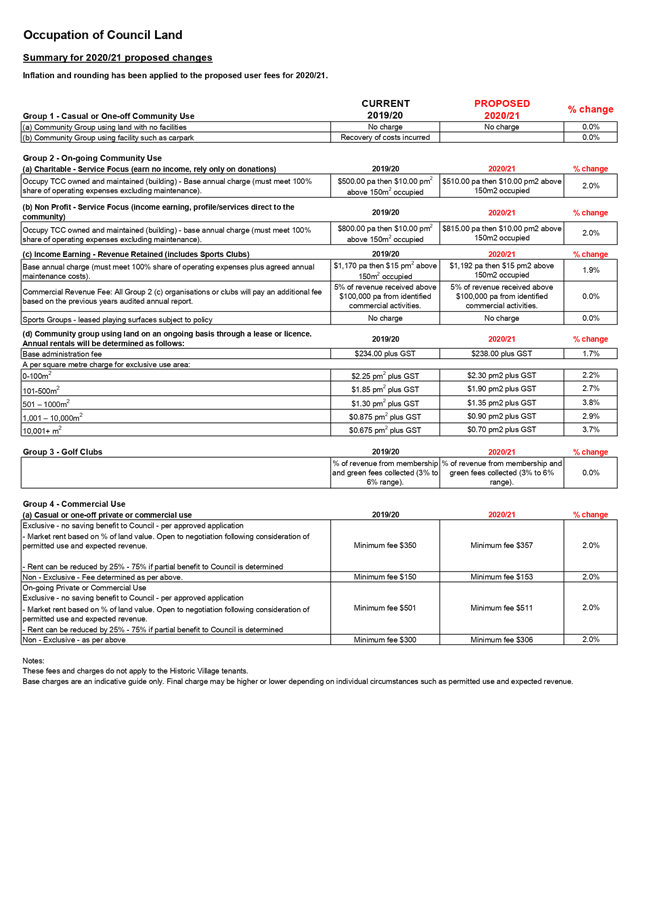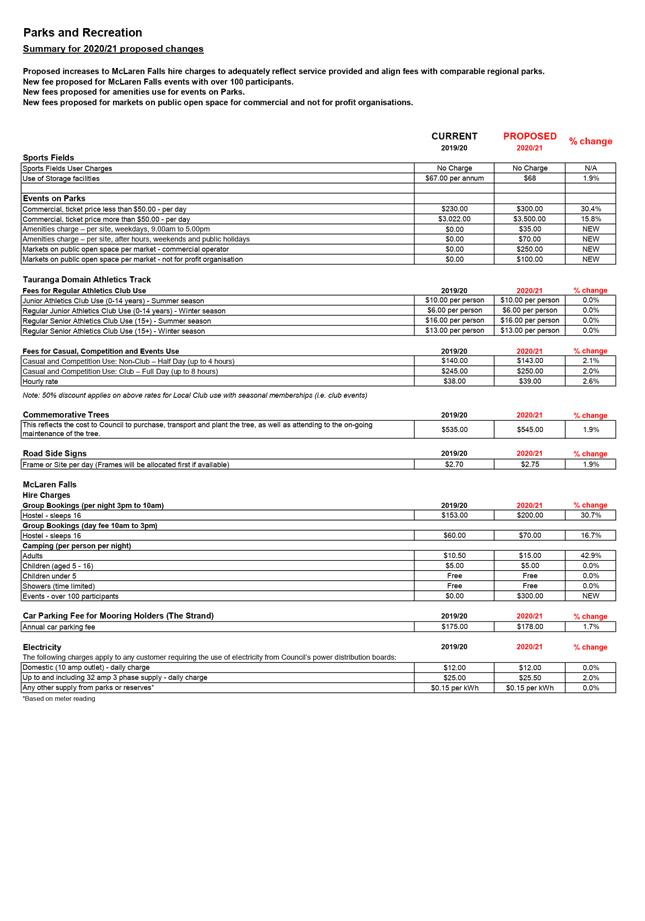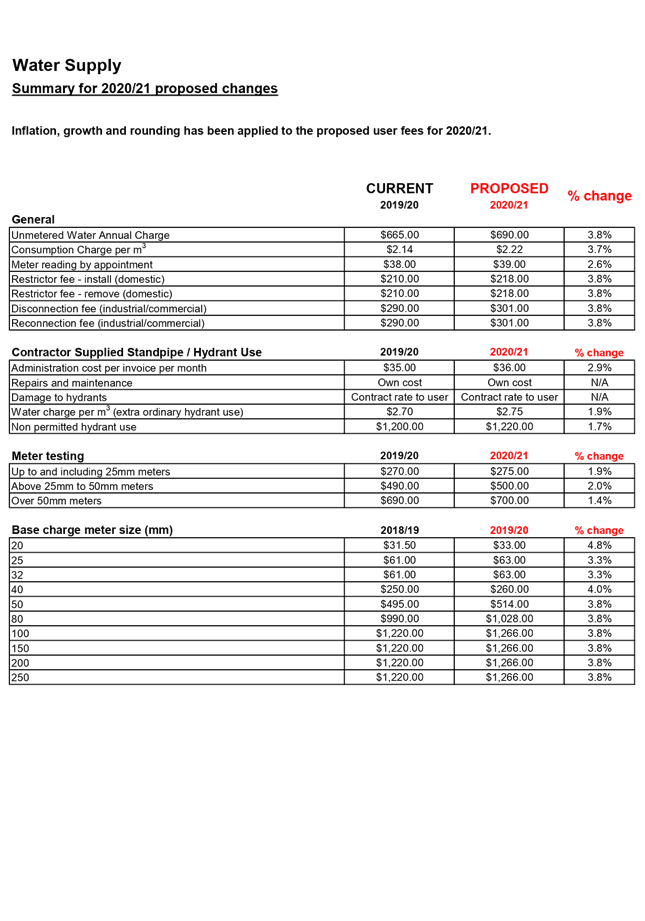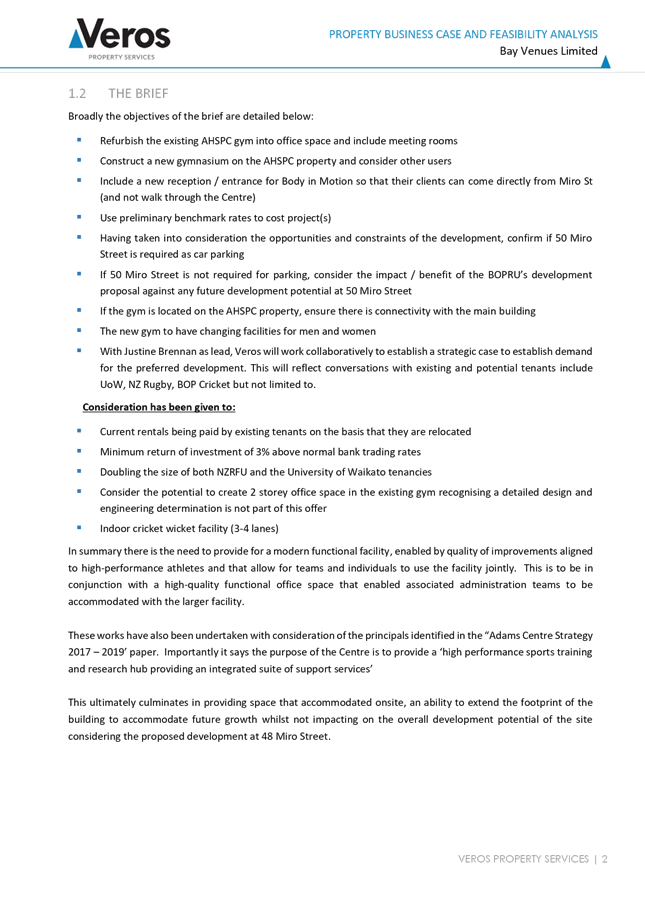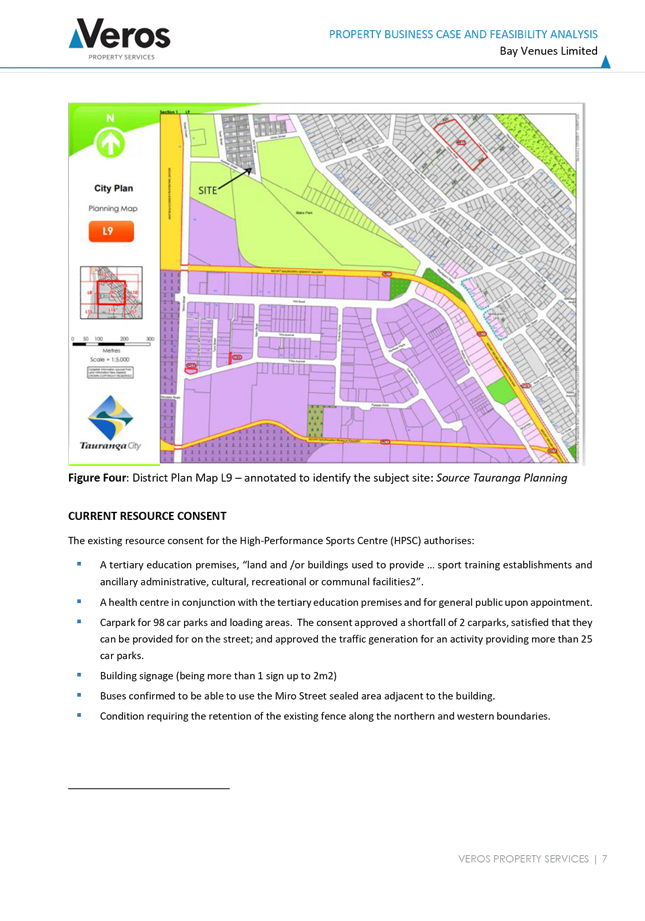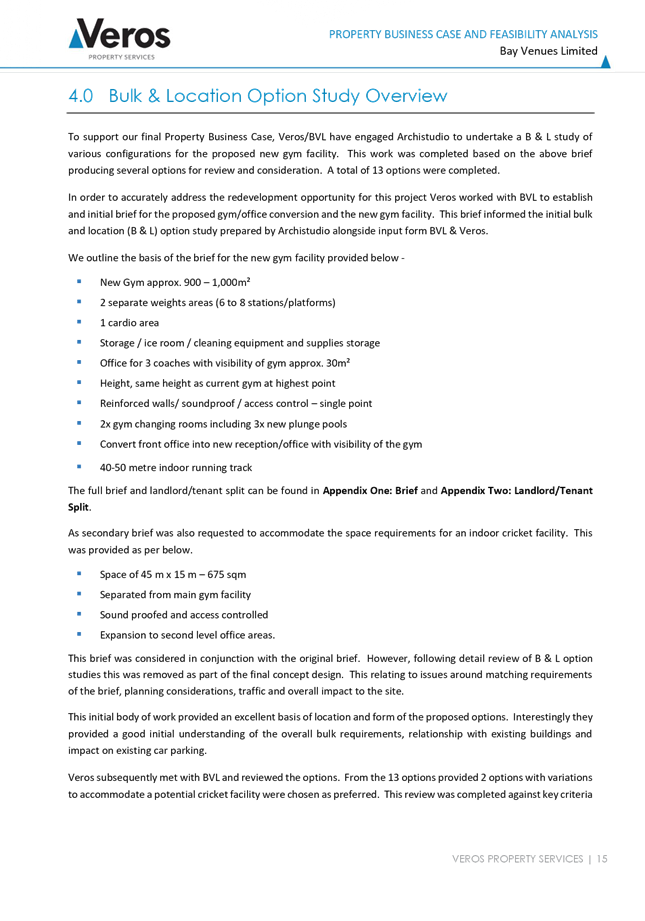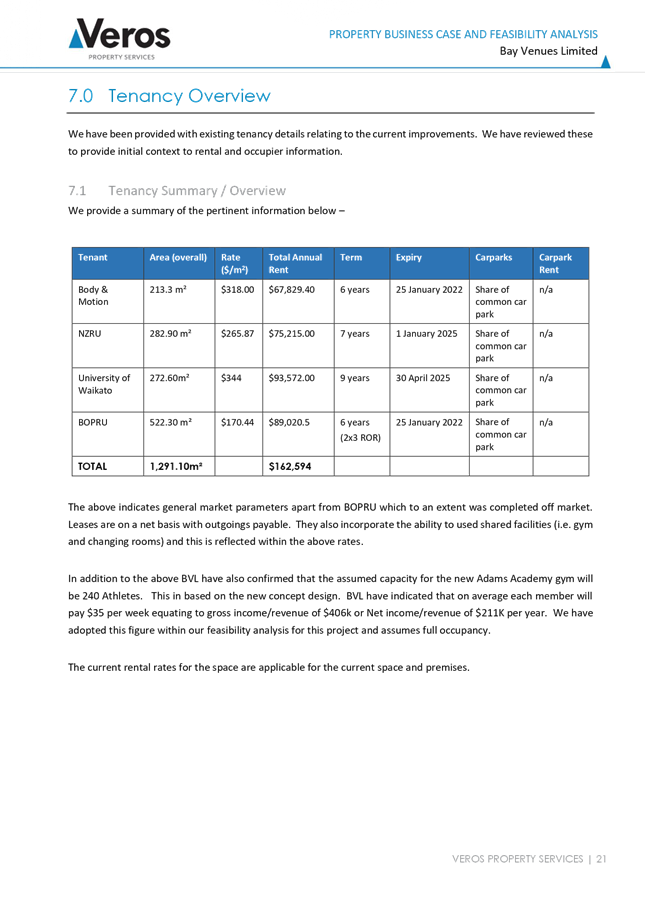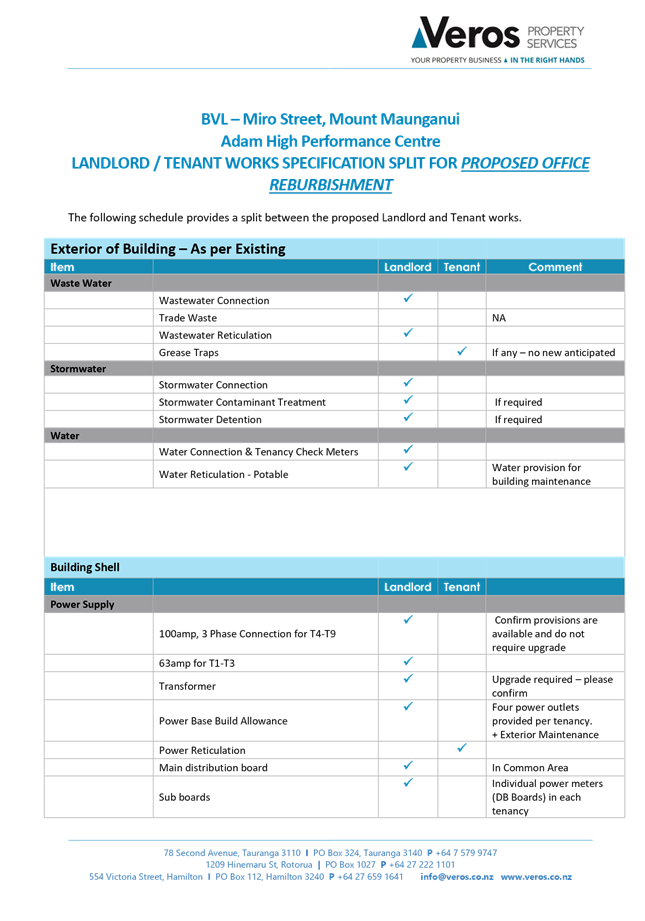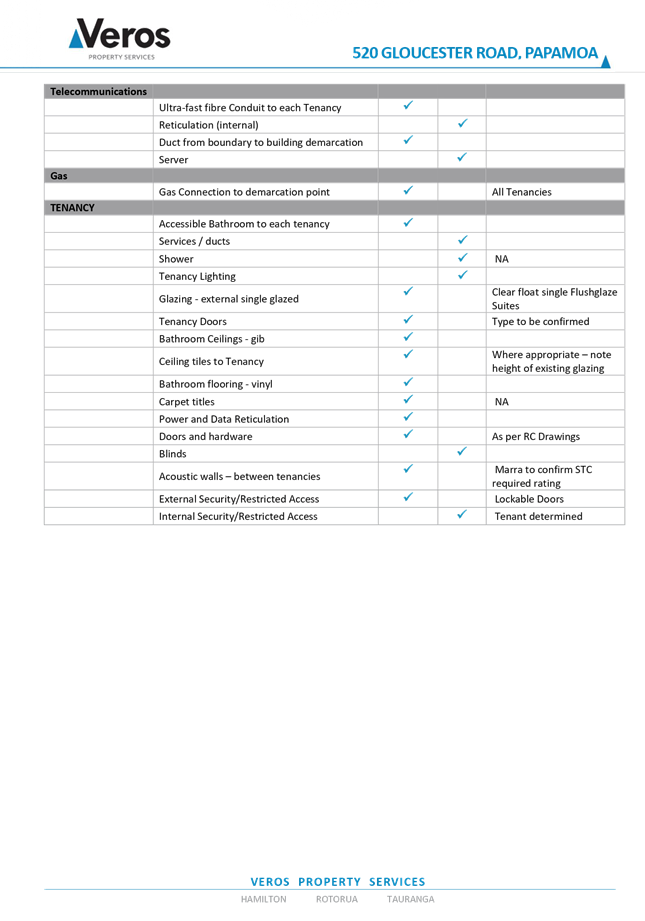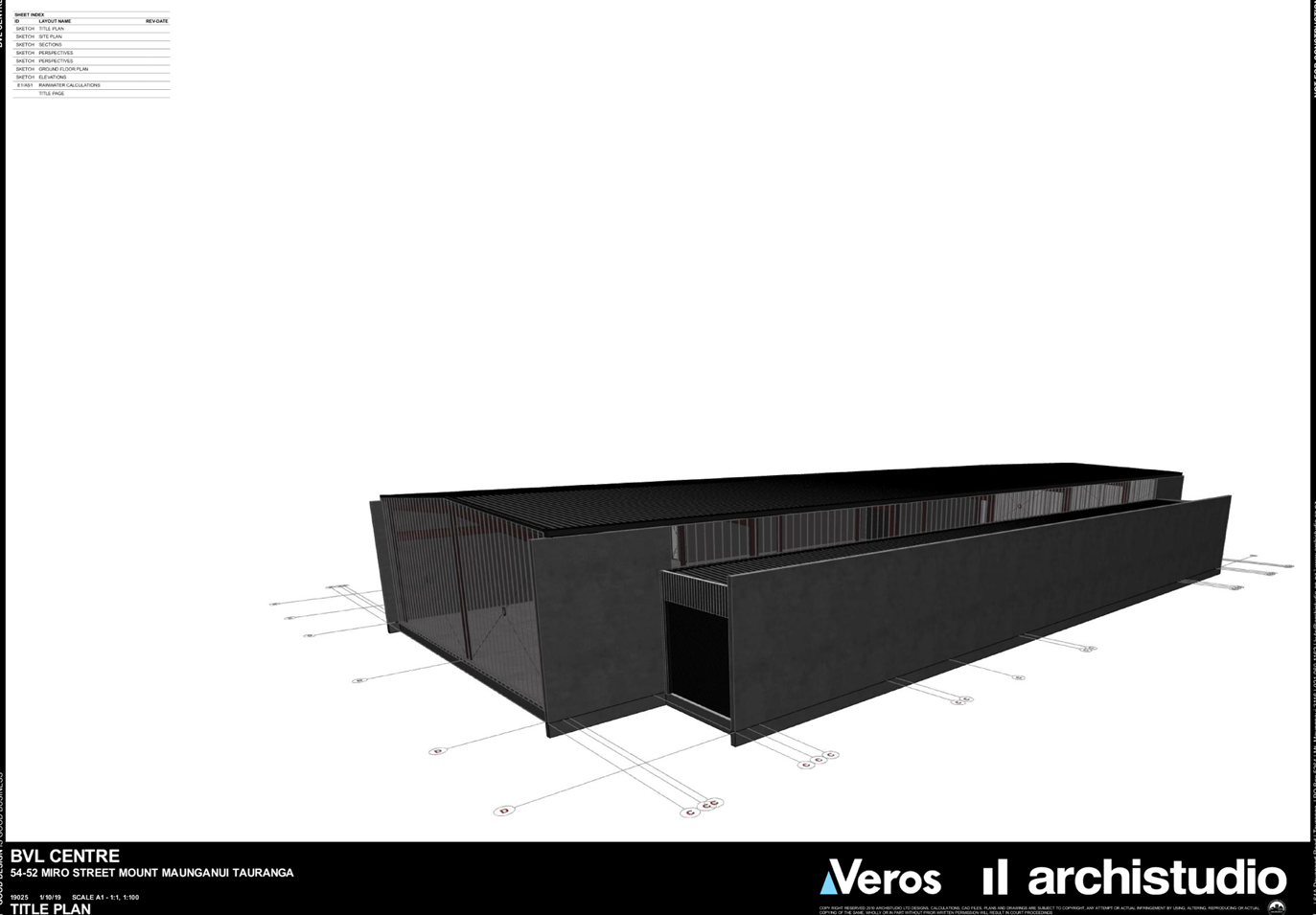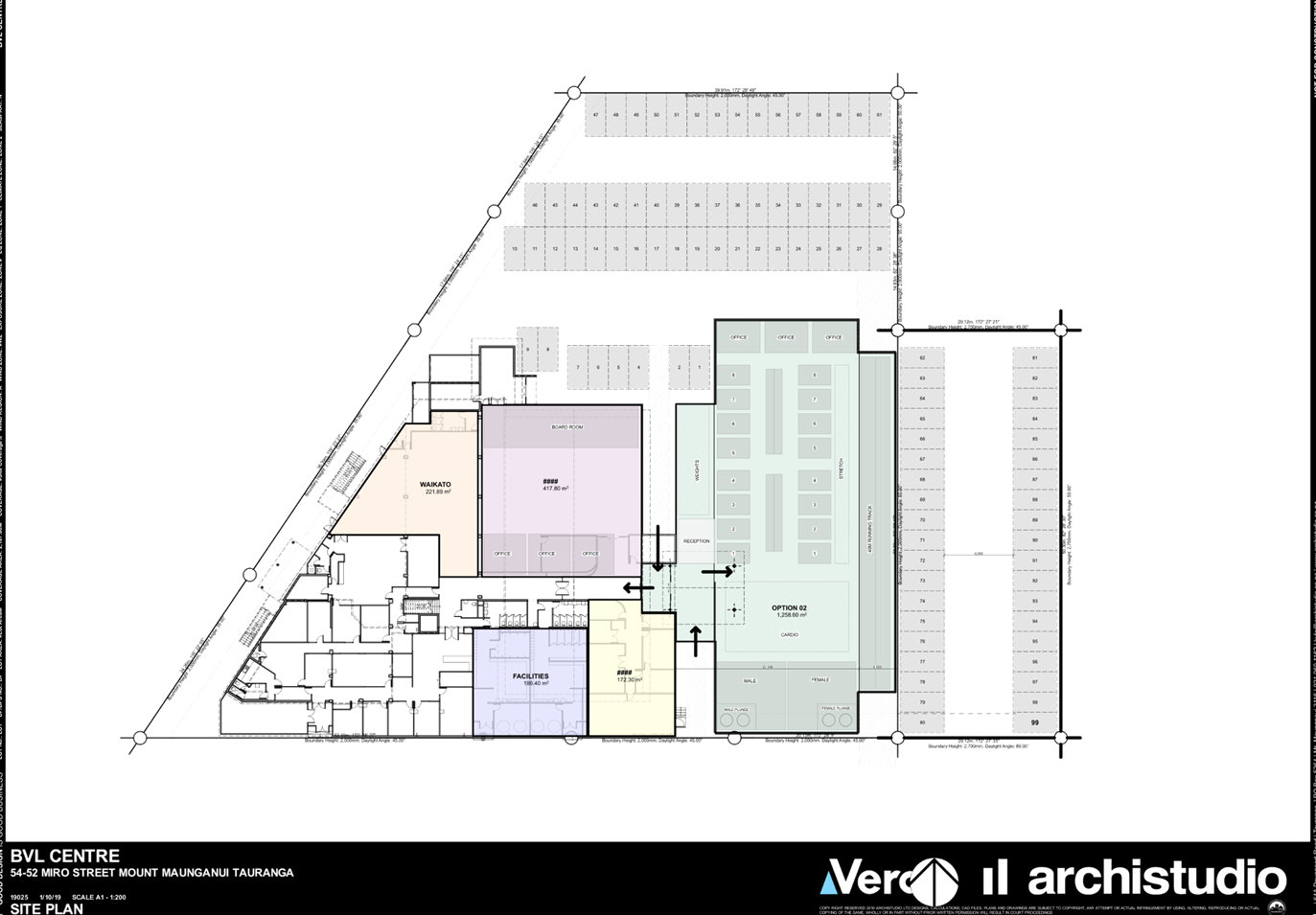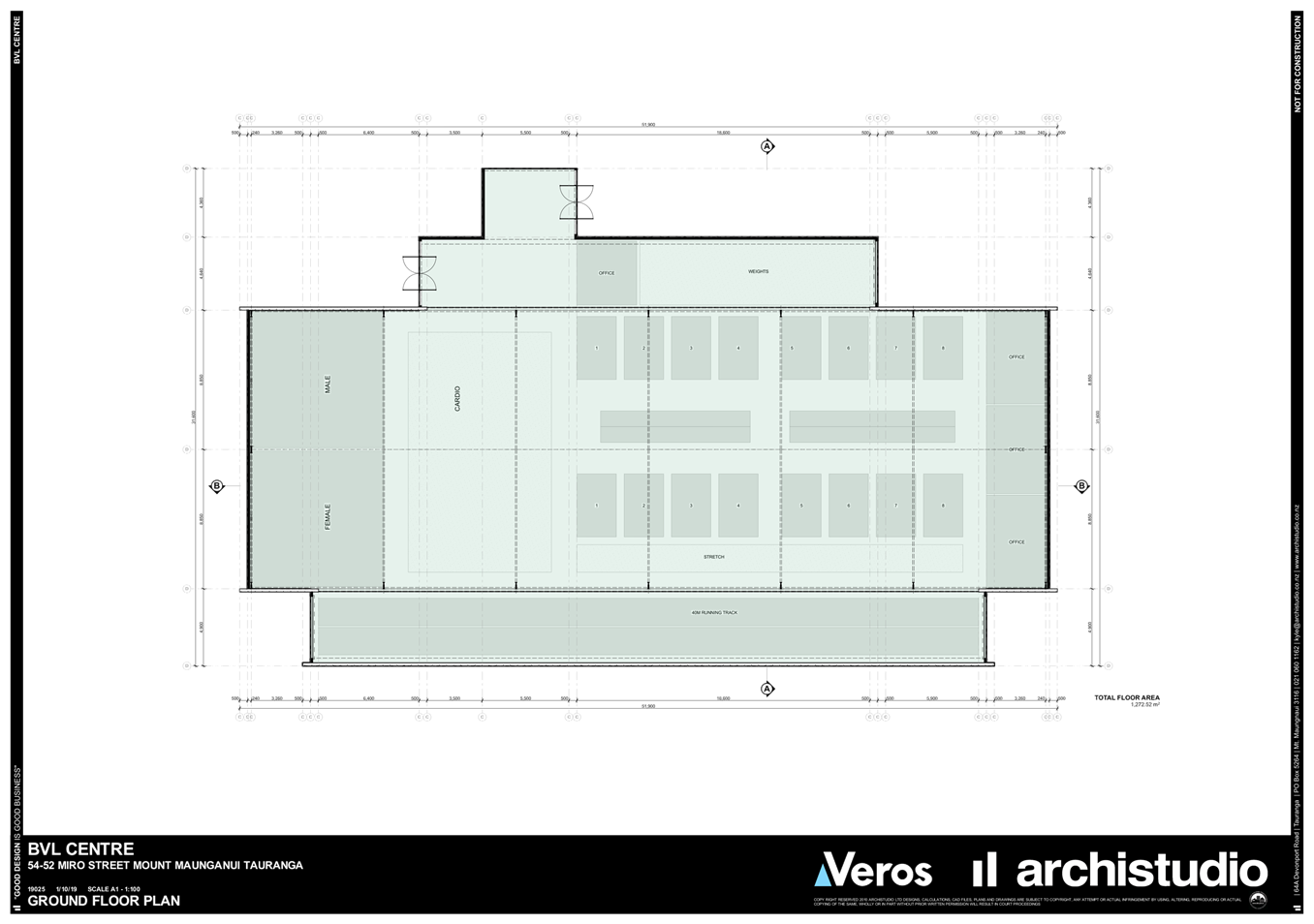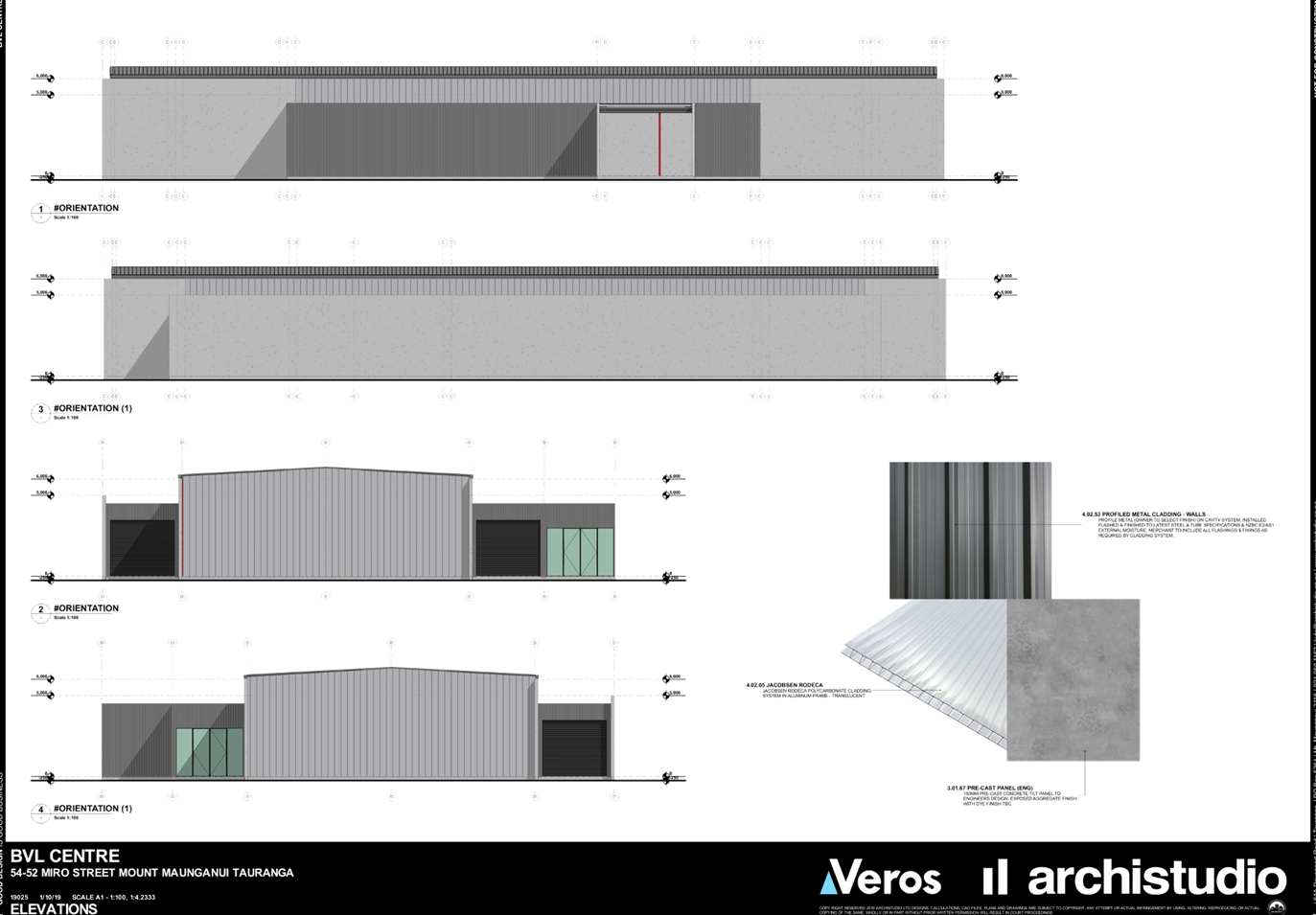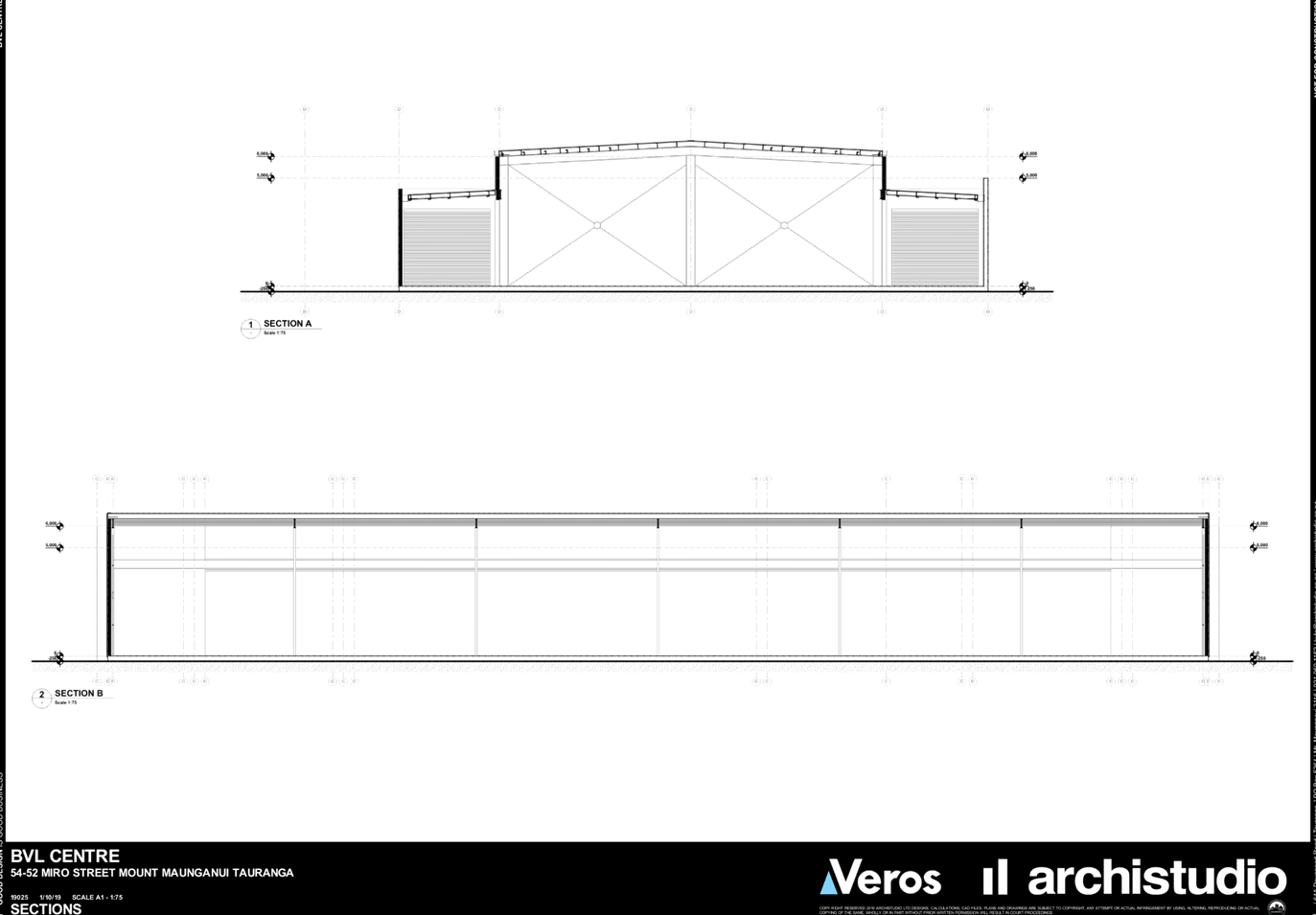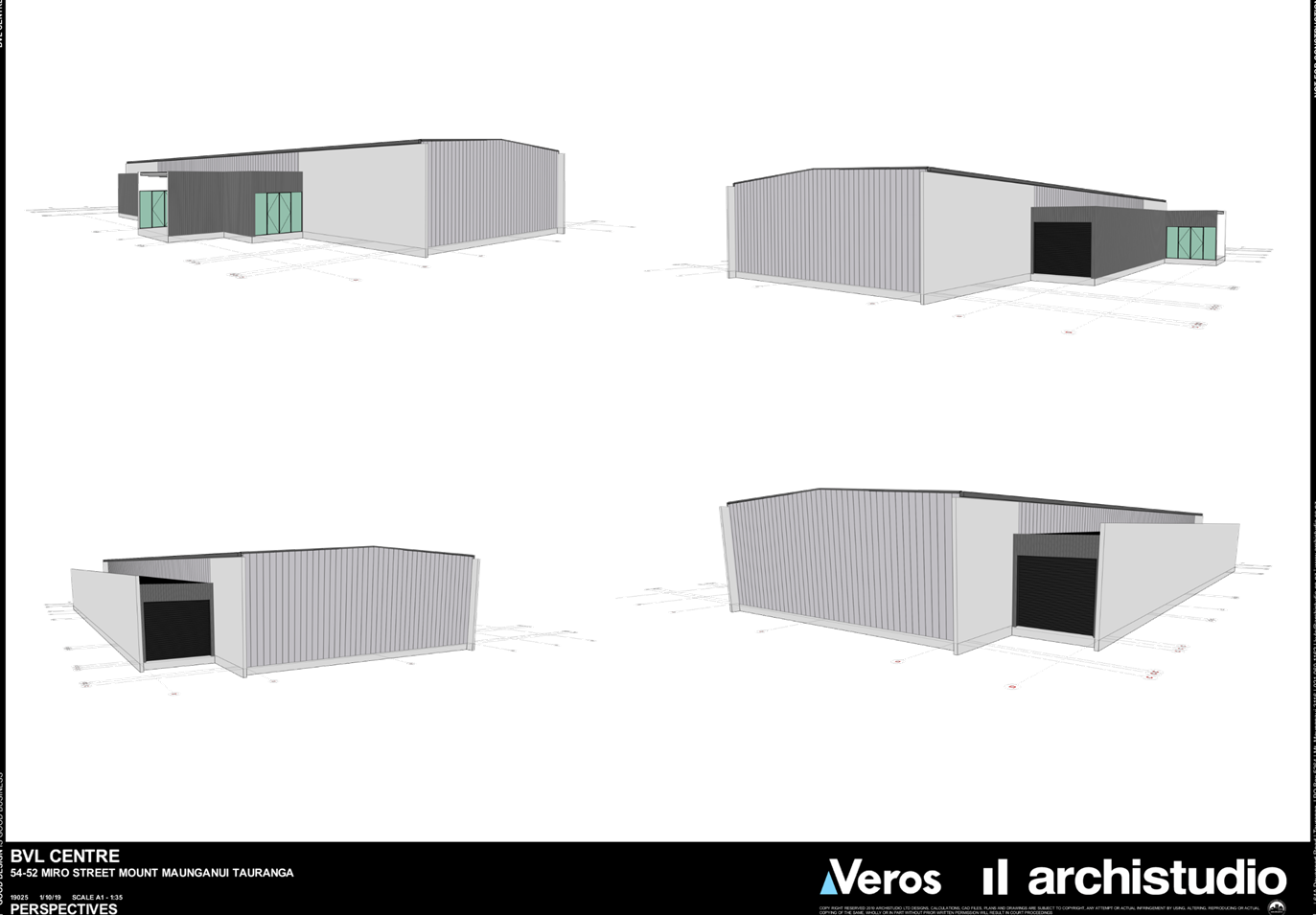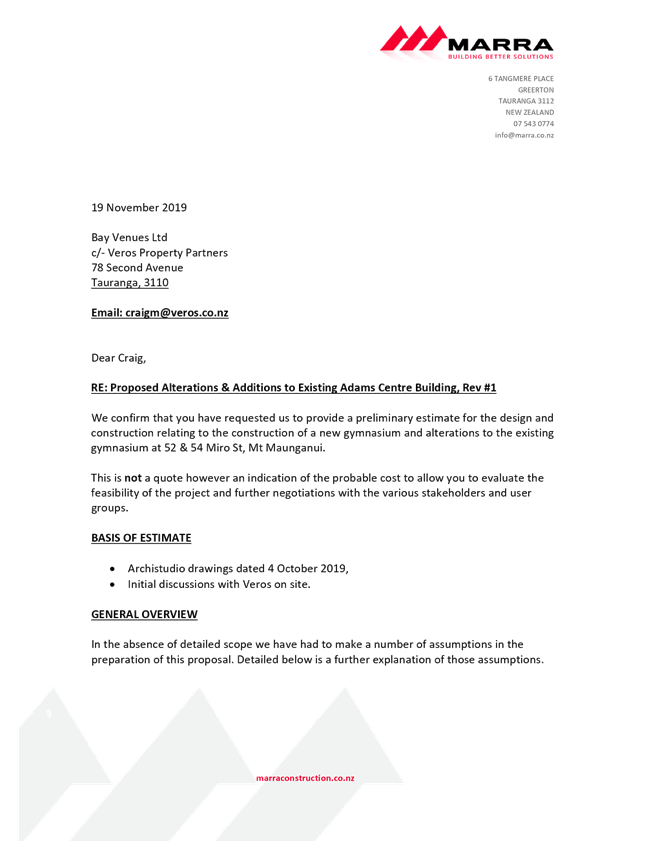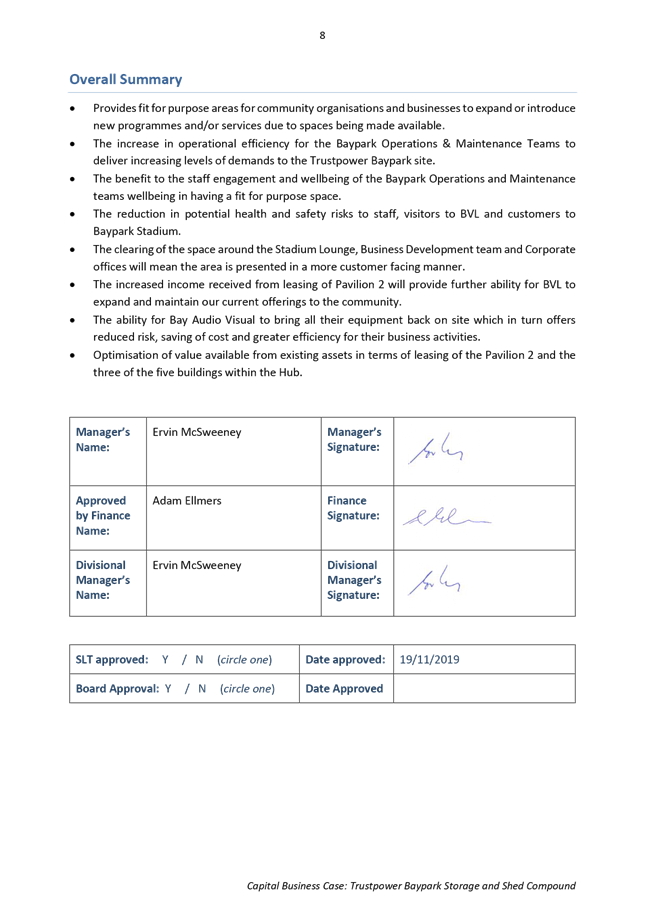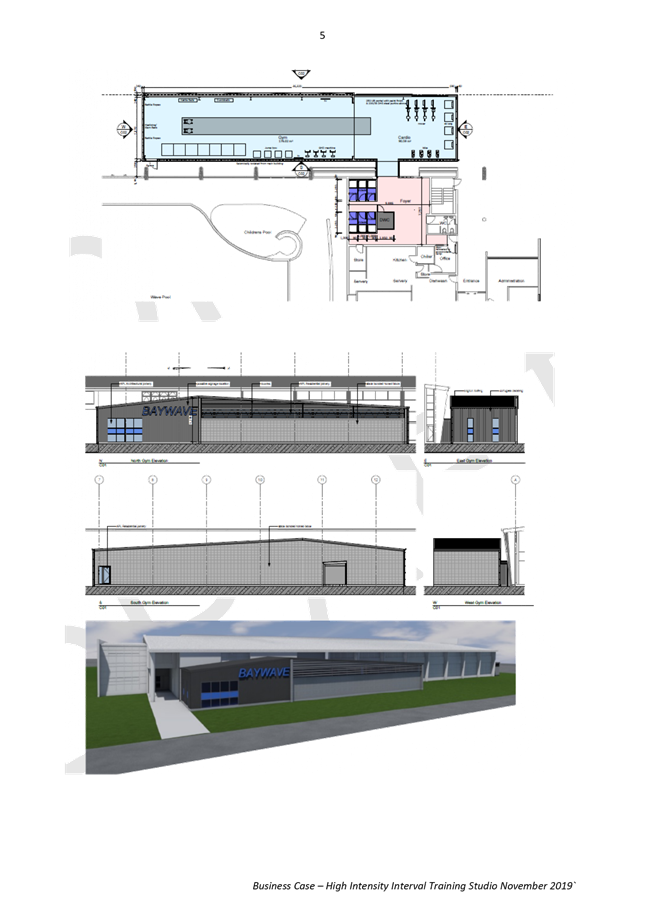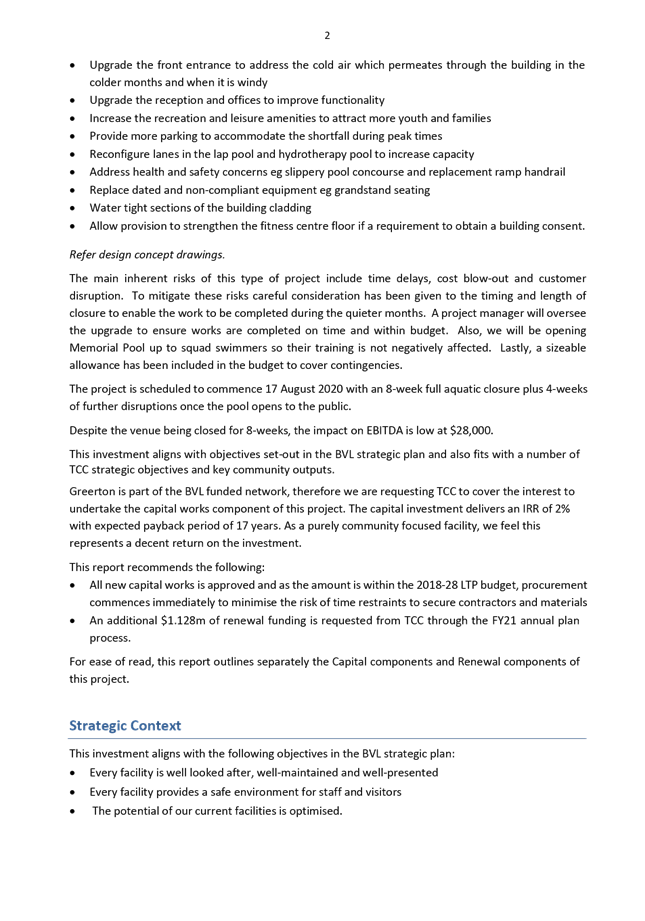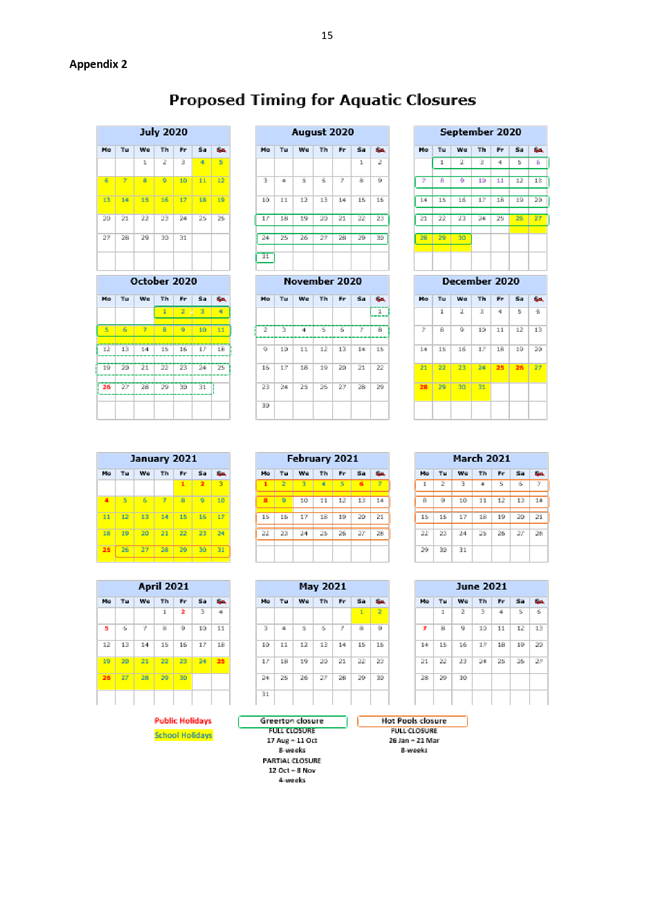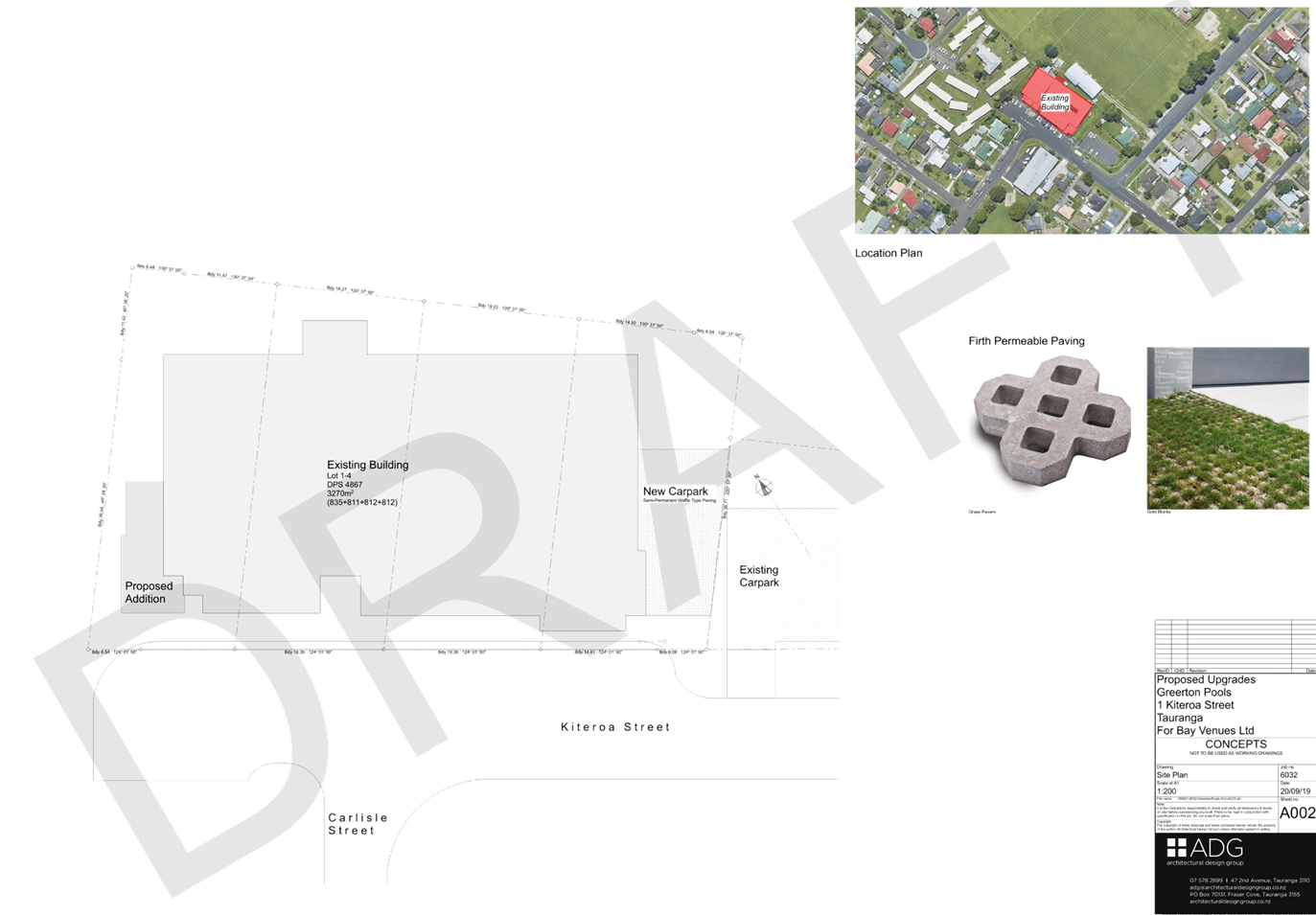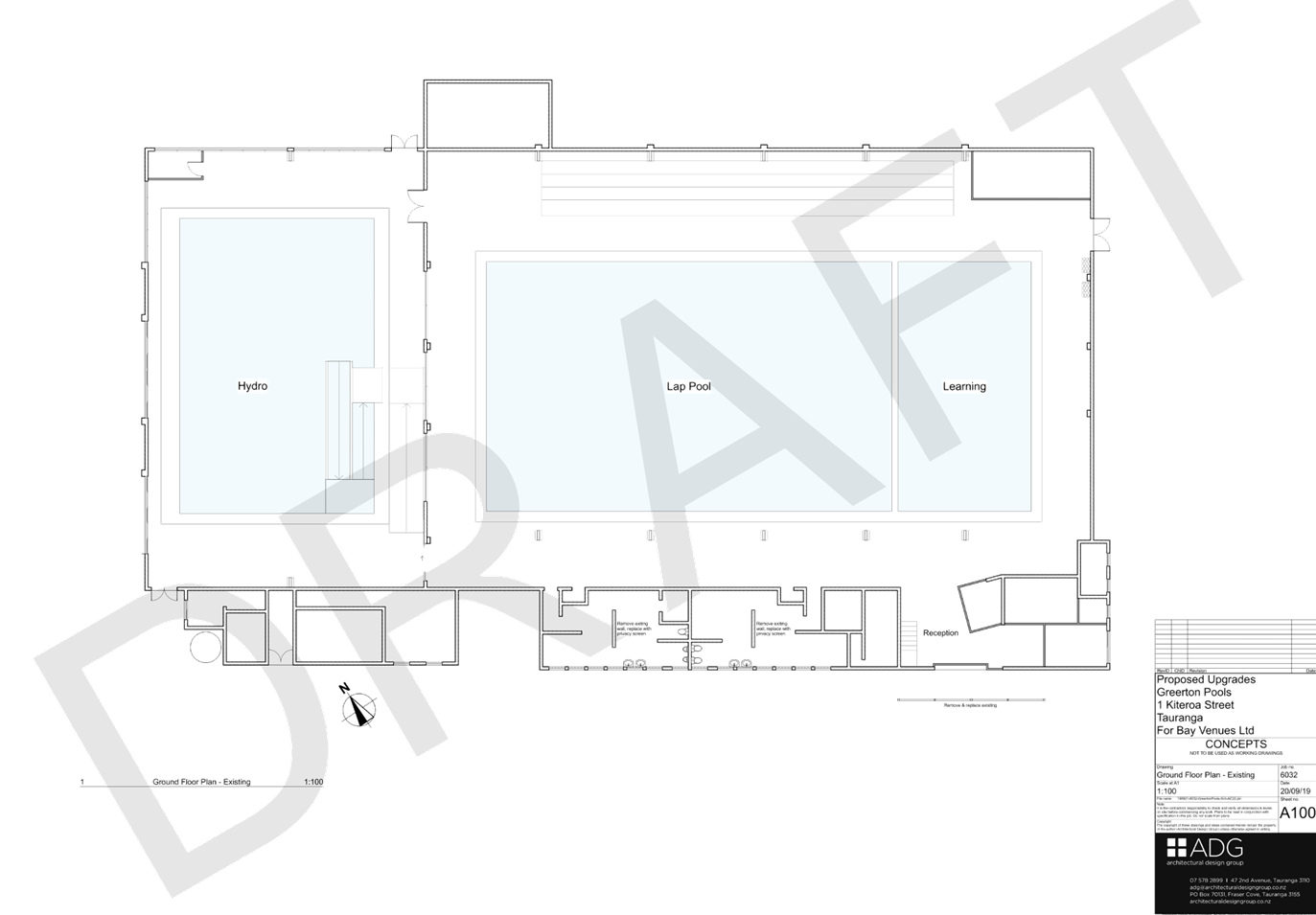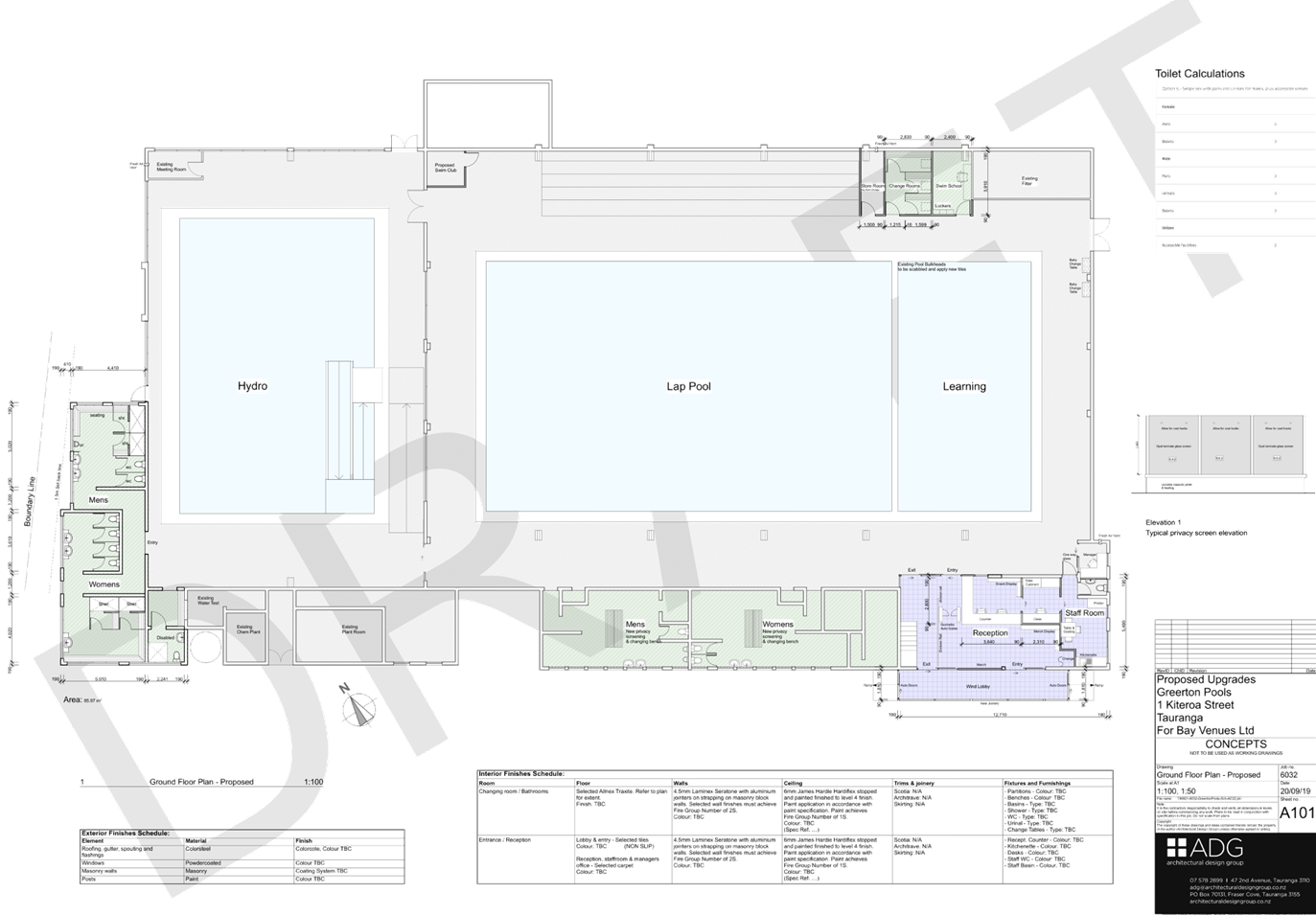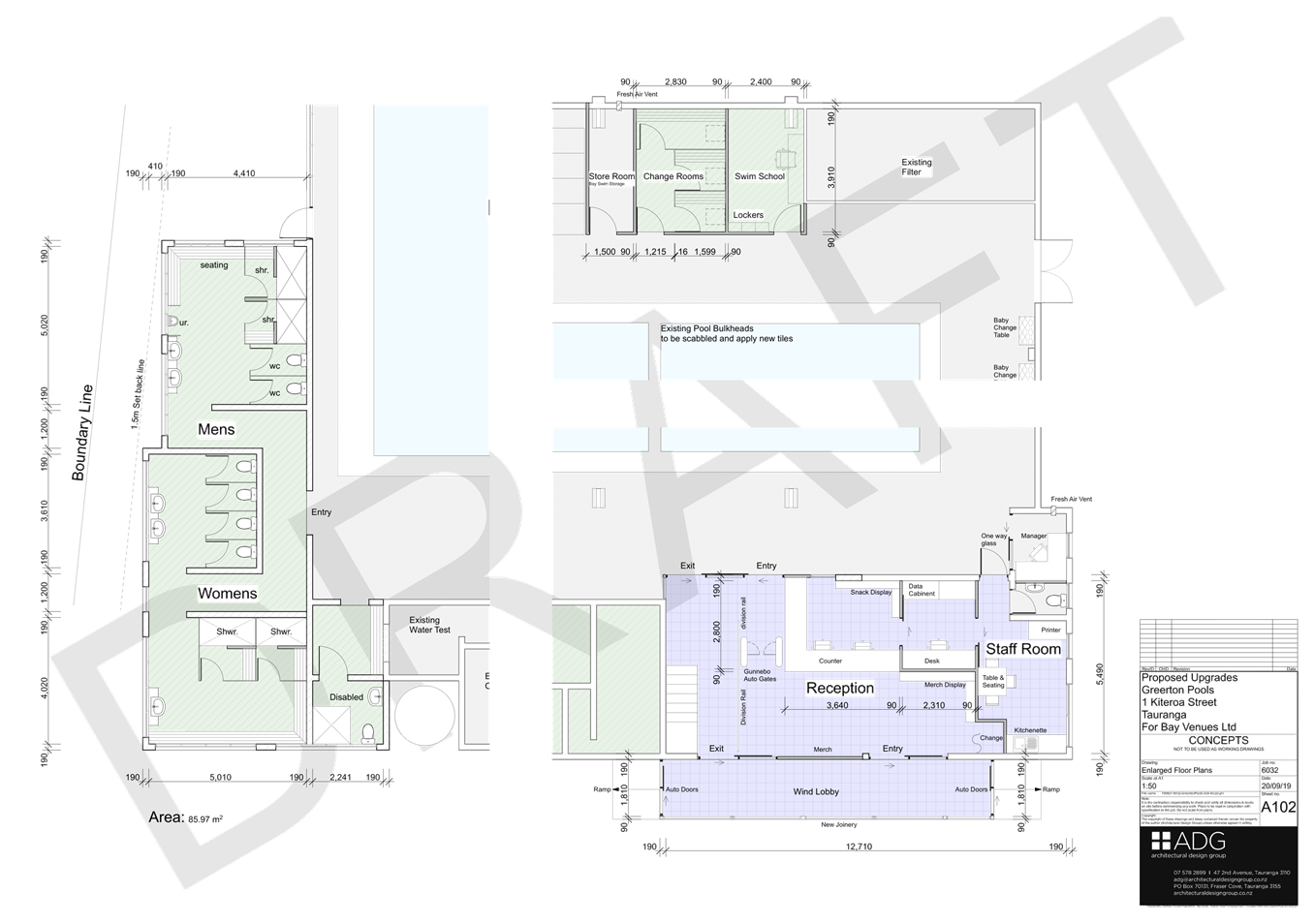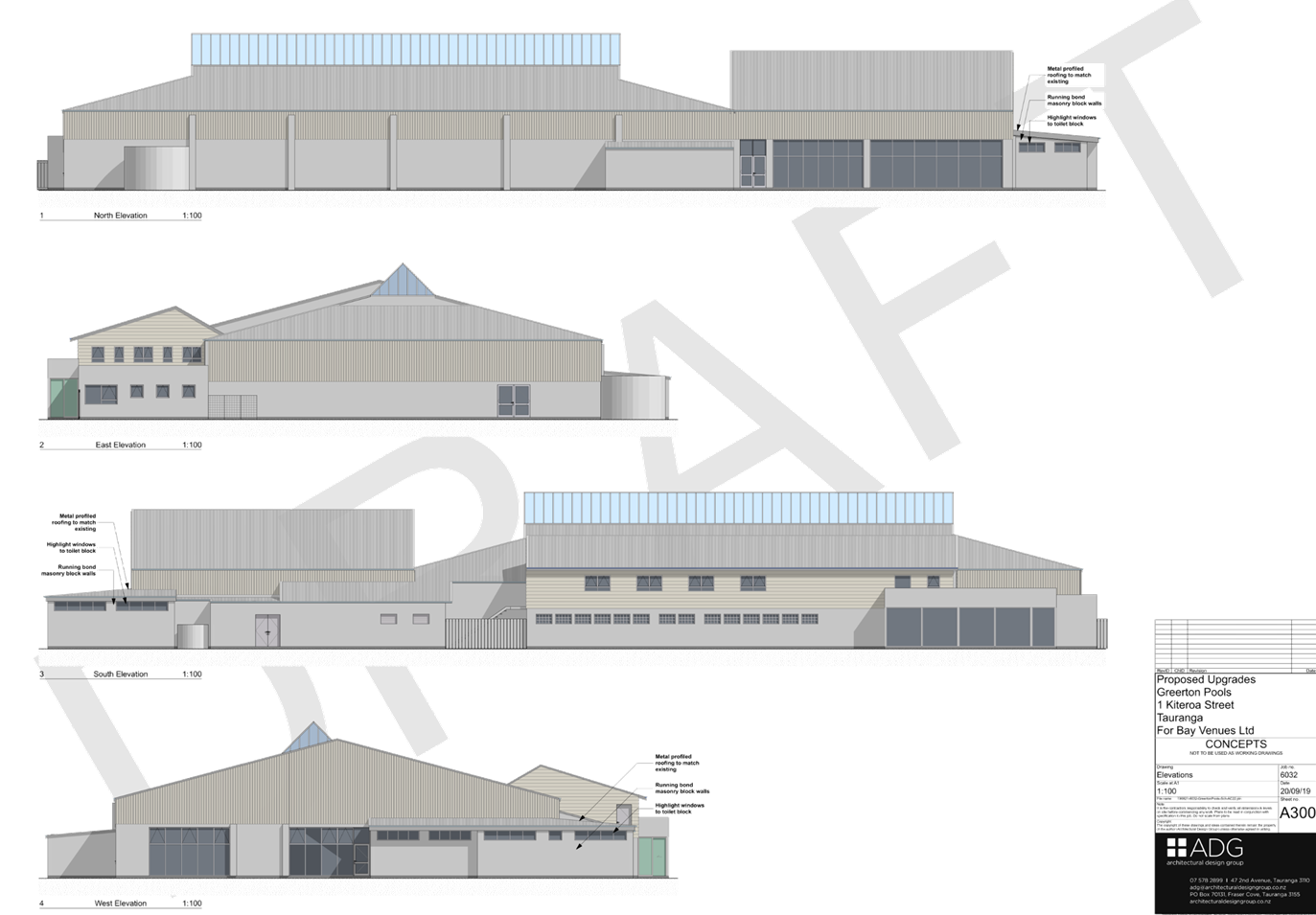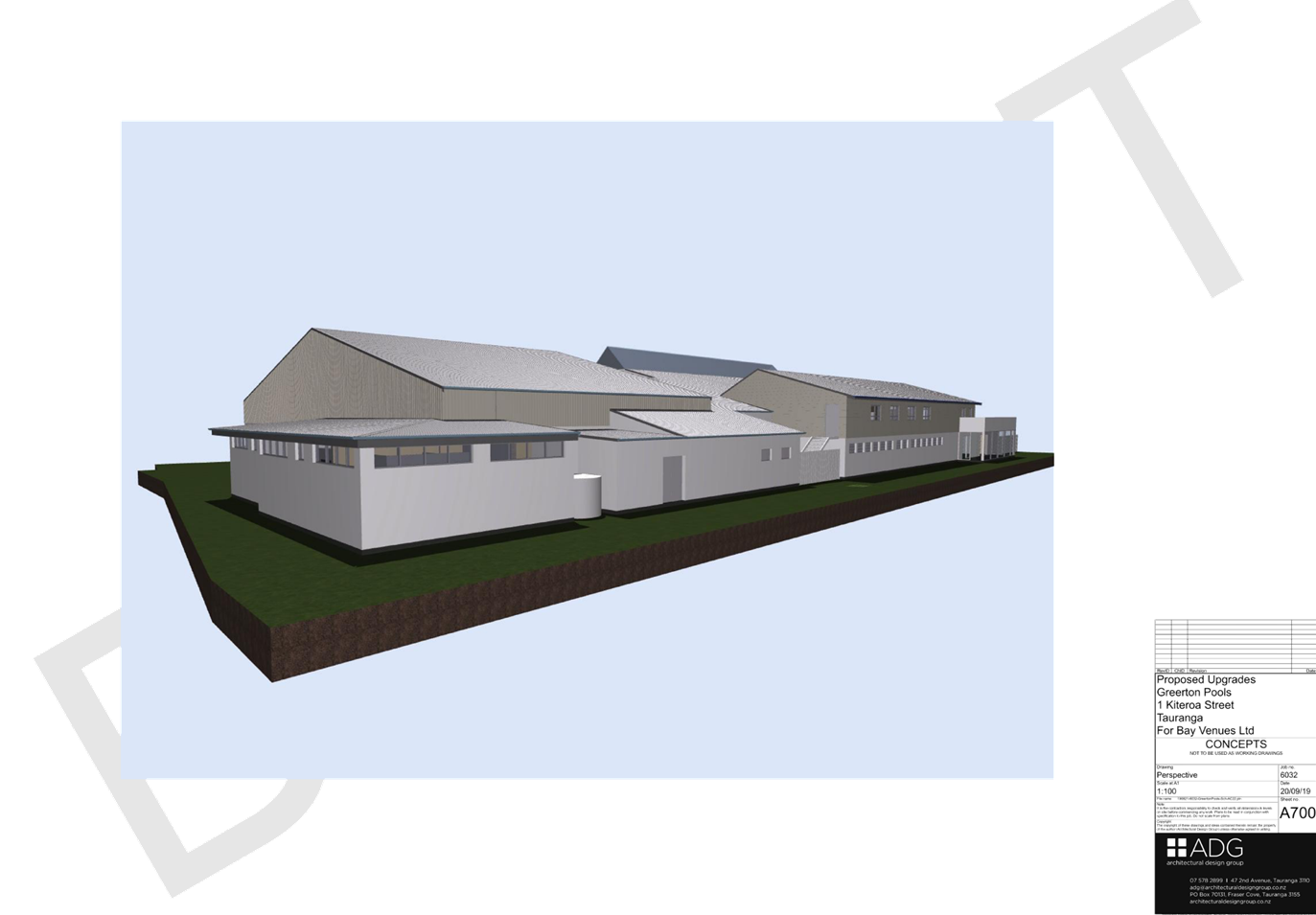|

|
|
AGENDA
Policy Committee Meeting
Wednesday, 19 February 2020
|
|
I hereby give notice that a Policy Committee Meeting
will be held on:
|
|
Date:
|
Wednesday, 19 February
2020
|
|
Time:
|
2pm
|
|
Location:
|
Tauranga City Council
Council Chambers
91 Willow Street
Tauranga
|
|
Please
note that this meeting will be livestreamed and the recording will be
publicly available on Tauranga City Council's website: www.tauranga.govt.nz.
|
|
Marty Grenfell
Chief Executive
|
7 Business
7.1 Bay
Venues Limited - Capital and Renewals Expenditure and Pricing Review Proposals
for the Draft Annual Plan 2020/2021
File
Number: A11167519
Author: Anne
Blakeway, Manager: CCO Relationships and Governance
Authoriser: Gareth
Wallis, General Manager: Community Services
Purpose of the Report
1. The
purpose of this report is to present Bay Venues Limited’s (BVL) proposed
capital and renewals expenditure and entry pricing for the Draft Annual Plan
2020/2021.
|
Recommendations
That the Policy Committee:
(a) Receives
Bay Venues Limited’s submission to the draft Annual Plan 2020/2021;
(b) Agrees
to incorporate Option 1b into the capital list for prioritisation in the
draft Annual Plan 2020/2021 going to Council in March, prior to community
consultation.
This option incorporates some
elements of Bay Venues Limited’s capital programme – in addition
to other minor new capital projects totalling $346,757 – and their
associated budgets, namely:
(i) the
Greerton rejuvenation project ($1,103,666); and / or
(ii) the
Adams Centre expansion project ($5,351,412).
(c) Defers
the following proposal for consideration in the Long Term Plan 2021-2031:
(i) Operations
Hub at Trustpower Baypark ($2,264,589)
(ii) Expansion
of Clubfit Baywave ($2,403,000); and
(iii) Baypark
Events Centre ($4,900,000).
(d) If
Council approves the capital funding for (b)(i) and/or (b)(ii) above,
delegate authority to the Chief Executive to approve an amendment of Bay
Venues Limited’s existing loan agreement to reflect the approved
capital budget;
(e) Approves
Bay Venues Limited’s total renewals budget of $5,822,826 into the draft
Annual Plan 2020/2021 and include for community consultation;
(f) In
relation to Bay Venues Limited’s operating revenue, agrees to
incorporate into the draft Annual Plan 2020/2021 and include for community
consultation:
(i) Either
Option 2a – the pricing structure identified in the Recreation Sport
and Leisure Consultancy Ltd (RSL) pricing review report, along with
RSL’s pricing schedule included in Attachment 3.
(ii) Or
Option 2c – the hybrid model proposed by Bay Venues Limited (BVL),
along with BVL’s proposed pricing schedule included in Attachment 3.
This would enable some increase in user fees and charges ($400,000), with the
remainder of the shortfall to be provided through an increase to the rates-funded
operating subsidy ($150,000 plus CPI).
|
Executive Summary
2. BVL
has provided its submission to inform the development of the draft 2020/2021
Annual Plan, with a summary provided as Attachment 1. It provides information
that supports initiatives associated with capital projects, investment in
renewals and its operational budget.
3. The
submission includes a proposal for the inclusion of four major capital projects
– three of which are new projects and one, Greerton Aquatics and Leisure
Centre, was previously approved as part of the Long Term Plan (LTP) 2018-2028.
Together, these four projects represent an increase in new capital funding of
$5,370,724 from what was included in the LTP.
4. The
total renewals budget is $5,822,826, which is an increase of $1,312,375 on what
was approved as part of BVL’s submission to the LTP.
5. In
terms of operational funding, BVL has undertaken a comprehensive review of
profitability in the funded community network, which has indicated that a
revenue increase of approximately $550,000 is required to offset additional
operating costs incurred over recent years.
6. A
report (Attachment 2) from specialist leisure industry consultants, Recreation
Sport and Leisure Consultancy Limited (RSL), recommends price increases
throughout the funded network, which would simplify the complex pricing structure
and generate additional revenue of $534,717. RSL’s recommended pricing
schedule is included as Attachment 3.
7. As
an alternative to passing the full cost on to users, BVL has suggested a hybrid
model of cost recovery, which includes some increases to user fees and charges,
with the remainder of the shortfall provided through an increase to the
rates-funded operating subsidy of $150,000. BVL’s proposed price
increases are included as Attachment 3. They are less than those recommended by
the RSL Pricing Review, however they still require Council approval as they are
greater than CPI.
8. It
is noted that the operating subsidy provided to BVL in return for delivering
community outcomes has not increased above CPI since the inception of the
organisation, despite a significant increase in user numbers over this time.
9. BVL
are seeking Council approval for either the full RSL pricing schedule, or their
proposed hybrid model (Attachment 3) to be included for community consultation
through the 2020/2021 Annual Plan process.
BACKGROUND
10. BVL
has provided its submission to inform the development of the draft 2020/2021
Annual Plan (Attachment 1). It provides information that supports initiatives
associated with capital projects, investment in renewals and its operational
budget.
11. In addition,
each of the major new capital projects is supported by a detailed business
case, which has been approved by the BVL Board and submitted to Council staff
as per the requirements of the Enduring
Statement of Expectation. The detailed business cases are provided in Attachment
4.
Significant capital projects requested
12. BVL’s
submission proposes inclusion into the Annual Plan 2020/2021 of four major
capital projects requiring Council approval as per the $200,000 threshold in
the Enduring Statement of Expectation.
13. Three
of the major capital projects are new projects and one, Greerton Aquatics and
Leisure Centre, was previously approved as part of the LTP.
14. Together
these four projects represent an increase in new capital funding of $5,370,724
from what is already in the LTP. Note: this figure includes the deferral of
another significant project currently in the LTP, the Baypark Events Centre,
with a detailed breakdown included in BVL’s submission (Attachment 1).
15. The
new capital projects are:
(a) Trustpower
Baypark Storage Compound and Operations Hub: $2,264,589
Construction of a multi-bay
storage compound, which will provide facilities for BVL Operations and
Maintenance staff and equipment. A component of the storage compound would also
be available for lease to generate revenue.
(b) UoW Adams
Centre High Performance Centre (Adams Centre): $5,351,412
Expansion of the University of
Waikato Adams Centre for High Performance by creating a new purpose-built gym
adjacent to the Centre, repurposing the existing gym into office space and
utilising the neighbouring BVL property at 50 Miro Street to provide the
required car parking.
(c) High
Intensity Interval Training Studio (HIIT): $2,403,000
Construction of a 285m2 high
intensity fitness training studio at Clubfit Baywave to expand the product
offering and maximise utilisation and revenue returns.
(d) Greerton
Aquatic & Leisure Centre (Greerton): $1,103,666
This project has both a new
capital and a renewals component. BVL have already had a business case approved
through the LTP for the capital works however these were delayed due to the
Baywave closure taking priority. In the interim, BVL have identified additional
renewals required, resulting in an additional $1.128m of renewal funding being
requested through the Annual Plan 2020/2021 process.
Options Analysis – CAPITAL
PROJECTS
Option 1a: Incorporate Bay Venues
Limited’s total capital programme and associated budgets into the draft
Annual Plan 2020/2021 for community consultation.
16. Agree
to support the capital programme outlined in Attachment 1, along with detailed
business cases (Attachment 4). Incorporate the capital funding into the draft
Annual Plan 2020/2021 for community consultation.
17. If
this option is approved, Council will need to amend BVL’s existing loan
agreement to reflect the approved capital funding. It is recommended that this
is delegated to the Chief Executive.
18. If the
projects were to go ahead, the BVL debt to equity ratio as stated in the
current ESE would need to be reviewed.
|
Advantages
|
Disadvantages
|
|
· Approving this submission
enables BVL to operate commercially, using community facilities to grow
financial and non-financial returns.
· Greerton –
improvements to an important but ageing aquatic facility to continue to meet
the needs of Tauranga’s growing community and remedy several negative
issues at the facility, including inadequate changing room space, carparking,
entranceway and health and safety concerns.
· Baypark
Operations Hub – increased operational efficiency and effectiveness,
reduction of Health and Safety risks. Financial benefits through rental of
storage units and Pavilion help subsidise the cost of providing community
outcomes across the wider network. Cost savings of no longer having to rent
external storage for Bay AV equipment.
· Adams Centre
– resolves immediate and urgent issues around capacity by providing
638m2 of additional office space. Enables growth of existing tenants who have
raised concerns about their ability to commit long-term in the absence of
growth potential. Expansion of Adams Academy programme for developing
community athletes.
· Clubfit
Baywave – opportunity to expand product offering and maximise
utilisation and revenue returns by increasing membership and relieving
capacity issues. Enables Clubfit to continue to play a significant role in
the BVL network, providing economic returns that help subsidise the cost of
providing community outcomes across the wider network.
|
· Further
increases to BVL’s capital funding will put pressure on TCC’s
debt limitations.
|
Option 1b: Incorporate some elements of Bay Venues
Limited’s proposed capital programme and associated budgets into the
capital list for prioritisation in the draft Annual Plan 2020/2021 going to
Council in March, prior to community consultation.
19. This
option incorporates some elements of Bay Venues Limited’s capital
programme outlined in Attachment 1, along with their detailed business cases
(Attachment 4) and associated budgets, into the capital list for prioritisation
in the draft Annual Plan 2020/2021 going to Council in March. This would
be in addition to other minor new capital projects totalling $346,757.
20. If
this option is approved, Council will need to amend BVL’s existing loan
agreement to reflect the approved capital funding. It is recommended that this
is delegated to the Chief Executive.
21. BVL
has indicated that the Greerton and Adams Centre projects have greater urgency
and that the Baypark Operations Hub and Clubfit HIIT studio could potentially
be deferred to the LTP.
22. The
advantages and disadvantages of Council approving both projects have been
analysed below.
|
Advantages
|
Disadvantages
|
|
· Reduces the
level of additional capital funding required for BVL by $4,667,589. The
capital budget would represent an increase of $703,135 over and above what is
already in the LTP budget for FY21.
· Enables the
Greerton project capital works to be progressed in conjunction with the
scheduled maintenance shut-down period in August 2020, thus maximising
efficiencies and minimising customer inconvenience.
· Aligns
TCC’s recent review of community facilities, which found Greerton to be
a vitally important aquatic facility within the network and one which is
currently operating at capacity. Maintaining asset condition becomes critical
to de-risking the high level of reliance on this facility.
· Supports the
significant momentum and success of the Adams Centre since inception and
leverages the investment already made by the city into this facility.
· Triples the
capacity of the Adams Academy, a subsidised community athlete development
programme, which provides essential support services for aspiring young local
athletes to develop their potential and compete on the national/international
stage.
· Mitigates the
weaknesses of the current Centre, including the capacity issues currently
faced by existing users, functionality issues in the current gym and the risk
of losing NZ Rugby as a key tenant following the Tokyo Olympics.
· Provide
flexibility to attract new tenants to the Centre and contribute further
revenue generation, while enhancing Tauranga’s reputation as a centre
of excellence for high performance sport.
· Expanding the
capacity of the Adams Centre and upgrading Greerton to support higher
utilisation enables BVL to meet its strategic objectives around community
participation, health and wellbeing outcomes.
|
· Not
approving the Operations Hub will mean that BVL operations staff remain in
substandard working conditions and BVL continue to incur costs for offsite
storage of equipment.
· Not approving
the Clubfit HIIT Studio will restrict BVL’s ability to grow membership
and revenue. Risks Clubfit losing customers who are seeking small group
training opportunities – the leading industry trend.
|
Option 1c: Do not incorporate
any of Bay Venues Limited’s proposed capital programme and associated
budgets into the draft Annual Plan 2020/2021 for community consultation.
23. Do not agree
to support any of the proposals outlined in Attachment 1 of this report.
|
Advantages
|
Disadvantages
|
|
· This
will reduce the level of capital funding required for BVL by $11,122,667.
|
· BVL
may be unable to respond to increases in demand for its facilities and
therefore unable to meet its performance and strategic objectives.
· Not
supporting the Adams Centre expansion sends a negative message about the
support for Tauranga as a centre of excellence for high performance sport and
will risk NZ Rugby assessing alternative locations to base their programme
for the long-term.
· Not
approving the Greerton capital works will restrict improvements to the level
of service and utilisation at this facility (i.e. new aquaplay and leisure
equipment to cater for families). BVL will not be able to remedy existing
major issues with the facility (more changing rooms, additional parking,
upgrading the outdoor space).
· Deferring all
capital and renewals works at Greerton has been identified as a major risk in
the Community Facilities Needs Analysis which identifies that Greerton will
experience proportionally the greatest increase in demand along with Baywave,
due to the proximity to the growth areas. In order to keep pace with the
demand, investment to address the facility’s shortcomings is
required.
|
Renewals
24. BVL
has provided a total renewals budget of $5,822,826, which is an increase of
$1,312,375 on what is currently included in the draft Annual Plan 2020/2021
budget.
25. The
increase is made up of a number of variations (both up and down), due to a number of major renewals being rescheduled to reduce
facility closure times. Further detail has been provided in BVL’s
submission (Attachment 1).
26. BVL’s
renewals programme is prepared in conjunction with TCC staff using
Council’s Accela Asset Management System.
27. Renewals
capital is funded from the depreciation reserve, i.e. rates collected in the
past, and does not impact on the Annual Plan 2020/2021 rates.
Operational revenue
28. BVL’s
Enduring
Statement of Expectation requires that BVL seek Council approval for any
price increases in the funded community network that are greater than CPI.
29. CPI
increases in revenue over the 2016-2019 period have been insufficient to cover
operational expense growth.
30. A
comprehensive pricing review of BVL’s funded community network has been
undertaken with assistance from industry experts Recreation Sport and Leisure
Consultancy Limited (RSL) and is provided as Attachment 2.
31. The
objective of the pricing review is two-fold – firstly to enable BVL to
recover cost increases in the funded network over recent years, and secondly to
simplify and rationalise charges. Currently the charging structure and
resulting entry prices across the network are overly complex and include a
multitude of variations between facilities within the same network.
32. In
order to offset the increases in operational expenses and to simplify and
streamline the complex pricing structure across the funded network, BVL are
seeking Council approval of the one of the pricing schedule options outlined
below (and included in Attachment 3) for community consultation through the
2020/2021 Annual Plan process.
Strategic / Statutory Context
33. As
a council-controlled organisation (CCO), BVL operates under an Enduring
Statement of Expectation (ESE) with Council. The ESE identifies the purpose
of BVL as:
“BVL exists to care for
and optimise community facilities to create value for Tauranga City and enhance
the quality of life of its people, now and into the future”.
34. Whilst
BVL is required to operate in a financially prudent manner and has agreed
financial targets, it’s purpose as a whole is to provide a service to the
community on behalf of Council rather than to operate a business for profit.
The predominant strategic driver for BVL is “maintaining and enhancing
accessibility for all”.
35. There
is very little strategic direction associated with the level of cost recovery
BVL is required to recuperate through users fees and charges. While the CCO is
expected to be financially prudent and achieve agreed financial targets, it is
also expected to ensure accessibility and affordability and high levels of
utilisation and satisfaction from facilities, while also aligning with the TCC
Revenue and Financing policy.
36. Currently
there is significant variation in the cost recovery achieved across different
facilities and facility types as indicated in the table below:
|
Facility Type
|
Community Centres
|
Community Halls
|
Indoor Recreation Centres
|
Aquatic Centres
|
Total Funded Network
|
|
Cost recovery (%) FY19
|
50%
|
83%
|
32%
|
55%
|
48%
|
37. The
Tauranga Aquatic Strategy indicates that the appropriate level of cost recovery
from users is 60-80%. Whilst no such targets exist for indoor courts, community
halls or community centres, this figure can be used as guide for the entire
funded network.
38. Going forward,
Council and BVL need to reach agreement on the cost recovery/subsidy targets
that BVL is expected to achieve within each of the facility types. If Council
desires certain facilities or activities to attract higher subsidies for
strategic reasons that too needs to be clearly articulated, agreed and
appropriately funded.
The Funded Network
39. Different
facilities and activities of BVL has different degrees of commercial or
community focus. This pricing review relates only to the funded network, which
includes the facilities with more of a community focus and which receive the
benefit of the subsidy provided by TCC in order to enable a greater degree of
accessible to the community. The funded network includes:
|
Community Aquatic Network
|
Community Indoor Sports Network
|
Community Hall Network
|
Community Centre Network
|
|
Baywave
Greerton
Otumoetai
Memorial
|
Trustpower Baypark Arena 6 court
QEYC & Memorial Hall
Aquinas Action Centre
Merivale Action Centre
Mount Sport Centre
|
Greerton
Bethlehem
Tauriko
Welcome Bay
Matua
Waipuna Pavilion
Elizabeth Street
Cliff Road
|
Arataki Community Centre
Papamoa Community Centre
Papamoa Sport and Rec Centre
|
40. BVL is
limited in the strategies they can implement to improve their profitability by
the ESE and Letter of Expectations (LOE) between TCC and BVL. Within the funded
network, BVL is only able to make price increases that are less than or equal
to CPI; beyond that a Council decision is required.
41. The
ESE also dictates that levels of service within community facilities are
expected to remain the same (or increase) so reducing what is on offer (either
reduced hours or closing some facilities) is not an option.
42. This
means that BVL is limited in how it can respond to the operational cost
increases it has incurred in the funded network over recent years.
Key Drivers of Pricing Review
Simplification of the current pricing structure
43. The
current pricing approach is complicated, varies between facility types and has
inconsistencies between different facilities in the network. BVL is seeking to
provide a simplified pricing strategy that is clear to customers and simple for
staff to implement.
44. With
new technology, customers will increasingly need to be able to self-manage
bookings, payments and memberships through online services. The pricing
strategy must support this.
45. The last change
to the pricing strategy, undertaken in 2018 was only minor in nature and
simplified the pricing approach for some, but not all facilities (by removing
peak and off-peak pricing differentials in some areas). In some cases, the 2018
price simplification resulted in a decrease in charges, particularly for
regular users at some high demand facilities and times e.g. at Trustpower
Arena.
Operational expense growth
46. CPI
based price increases are not keeping pace with operational cost increases.
Over the last four years, BVL funded network revenue growth has been insufficient
to cover operational expense growth. Operational expense growth has primarily
been driven by the following factors:
· General
operational expenditure required to maintain quality facilities at a high level
of service (e.g. cleaning, repairs and maintenance).
· Increases
in BVL staff remuneration to align closer to market rates (including minimum
wage increases) from an historically low base.
· Additional
support costs associated with compliance requirements (e.g. Health & Safety
and HR).
Increases in the cost of depreciation and debt
servicing on new capital items to enhance levels of service
47. Under
the ESE, BVL are responsible for funding the cost of depreciation and debt
servicing on all new capital items incurred post the restructure of the BVL balance
sheet in 2013, in both the funded and non-funded network. This results in the
cost of financing new capital items that are required to increase the level of
service to the community but do not have a corresponding revenue flow (i.e. new
changing rooms).
48. The change in
the financial performance of BVL from financial year 2016 to financial year
2020 clearly demonstrates these issues.
Table 1: Funded Network Financial variations FY16 -
FY20
|
|
FY16
|
FY20
|
Variance
|
|
User Fees
|
$2.379m
|
$3.065m
|
$0.685m
|
|
Subsidy
|
$2.496m
|
$2.670m
|
$0.174m
|
|
Operating Expenses
|
$4.692m
|
$6.099m
|
$1.407m
|
|
Net Surplus
|
$0.184m
|
$(0.364)m
|
$(0.548)m
|
Options Analysis –
OPERATING REVENUE
49. Due
to cost increases over the last four years, BVL estimates a revenue shortfall
across the funded network of $550,000 in FY21.
50. There are three
options for achieving this revenue objective:
Option 2a: Approve the pricing structure identified in
the RSL pricing review report and include for community consultation through
the 2020/2021 Annual Plan process
51. Agree
to support the proposals outlined in the RSL report (Attachment 2) and
incorporate into the draft AP, along with the pricing schedule included in
Attachment 3.
52. Average
percentage price change across the network would be as follows:
|
Facility
|
Average % price
increase
|
|
Aquatic general entry
|
8.2%
|
|
Aquatic lane and squad
|
39.5%
|
|
Aquatics memberships
|
25.6%
|
|
Indoor court facilities
|
20.6%
|
|
Community halls
|
13.0%
|
|
Community centres
|
39%
|
|
Funded network total
|
18.9%
|
|
Advantages
|
Disadvantages
|
|
· The
growing cost to operate the funded network is offset by users who benefit
from the facilities.
· Ratepayer
subsidy remains status quo.
· BVL
financial sustainability is maintained, net loss does not increase.
· Complex
pricing structure is simplified.
· Easier
for the customer to understand.
· Lays
the platform for digital transformation to occur e.g. online bookings.
· Consistent
approach to pricing across facilities.
· Better
alignment with nationally comparative facility entry prices.
· Allows BVL to
maintain and/or increase levels of service.
|
· Percentage
increases to some users could result in negative feedback and impact
negatively on affordability and accessibility.
· Potential
decline in volumes and utilisation.
|
Option 2b: BVL increases entry
prices across the funded network by CPI and Council funds the remainder of the
shortfall by increasing the rates-funded operating subsidy by $500,000 above
CPI. Include for community consultation through the 2020/2021 Annual Plan
process.
53. The
operating subsidy provided to BVL in return for delivering community outcomes
has not increased above CPI since the inception of the organisation, despite a
significant increase in user numbers over this time.
|
Advantages
|
Disadvantages
|
|
· No
impact on current users.
· No
impact on utilisation rates.
· BVL
financial sustainability is maintained, net loss does not increase.
· Allows
BVL to maintain and/or increase levels of service.
|
· Ratepayer
subsidy will increase by $500,000 above status quo.
· General
entry prices for non-residents are subsidised by Tauranga ratepayers to some
facilities.
· Complex
pricing structure legacy issues remain in place.
· Minimal
alignment with comparative national facilities.
|
Option 2c: Approve a hybrid
model, which would enable some increase in user fees and charges ($400,000),
with the remainder of the shortfall to be provided through an increase to the
rates-funded operating subsidy ($150,000 plus CPI). Include for community
consultation through the 2020/2021 Annual Plan process.
54. BVL
prefers this option as it achieves both the revenue and simplification
objectives and minimises impact on users.
55. BVL is seeking
Council approval for the schedule of price increases associated with this
option. Average percentage price change across the network would be as follows:
|
Facility
|
Average % price increase
Option
2c
|
Average % price increase
Option 2a
|
|
Aquatic general entry
|
7.4%
|
8.2%
|
|
Aquatic lane and squad
|
17.6%
|
39.5%
|
|
Aquatics memberships
|
24.3%
|
25.6%
|
|
Indoor court facilities
|
19.6%
|
20.6%
|
|
Community halls
|
13.0%
|
13.0%
|
|
Community centres
|
26.4%
|
39%
|
|
Funded network total
|
14.6%
|
18.9%
|
|
Advantages
|
Disadvantages
|
|
· Lower
impact on current users than option 2a, particularly aquatic lane swimmers,
squad swimmers and community centre users.
· Impact
on rates funded subsidy is $350,000 lower than option 2b.
· The
growing cost to operate the funded network is partially offset by user fees
charged to those benefiting directly from the facilities.
· Closer
alignment with comparative national facilities.
· BVL’s
financial sustainability is maintained, net loss does not increase.
· Allows
BVL to maintain and/or increase levels of service.
· Complex pricing
structure legacy issues largely resolved.
|
· Ratepayer
subsidy will increase by $150,000 above status quo.
· Percentage
increases to some users could still result in negative feedback and impact
negatively on affordability and accessibility, albeit less than option 2a.
|
Financial Considerations
56. The
financial implications are outlined in the above report and attachments.
Legal Implications / Risks
57. There
are no legal implications.
Consultation / Engagement
58. This
proposal, if approved by Council, will be subject to community consultation in
March 2020 as part of the Annual Plan 2020/2021 process.
Significance
59. Under TCC’s
Significance and Engagement Policy,
this proposal is of medium significance as it represents a significant amount
of capital and operational expenditure by Tauranga City Council’s largest
and most visible CCO.
NEXT
STEPS
60. Council
staff will continue to work with BVL to incorporate the approved capital and
renewals expenditure and entry pricing for prioritisation into the draft Annual
Plan 2020/2021, for development and consultation before adoption of the final
Annual Plan.
61. The
budgets and projects incorporated into the draft Annual Plan will inform the
development of BVL’s 2020/2023 Statement of Intent with Council.
62. Council
staff will work with BVL on a number of other recommendations from RSL in
relation to pricing of facilities, including:
· Agree on the
desired level of cost recovery from the funded network of facilities and
investigate ways to respond to communities in need, where affordability is
having a detrimental effect on participation.
· As part of the
next review of BVL’s Enduring Statement of Expectation, consider an
amendment that enables BVL to increase prices in the funded network up to a
maximum of 5% percent per annum without Council approval. Any amendments to the
ESE would need Council approval.
Attachments
1. Annual Plan
2020/2021 - BVL submission summary - A11169638 ⇩ 
2. Annual Plan
2020/2021 - BVL pricing review report by RSL - A11179228 ⇩ 
3. Annual Plan
2020/2021 - BVL detailed price increase schedule - A11179227 ⇩ 
4. Annual Plan
2020/2021 - BVL detailed business cases for AP submission - A11179233 ⇩ 
|
Policy Committee
Meeting Agenda
|
19 February
2020
|











|
Policy Committee Meeting Agenda
|
19 February
2020
|








































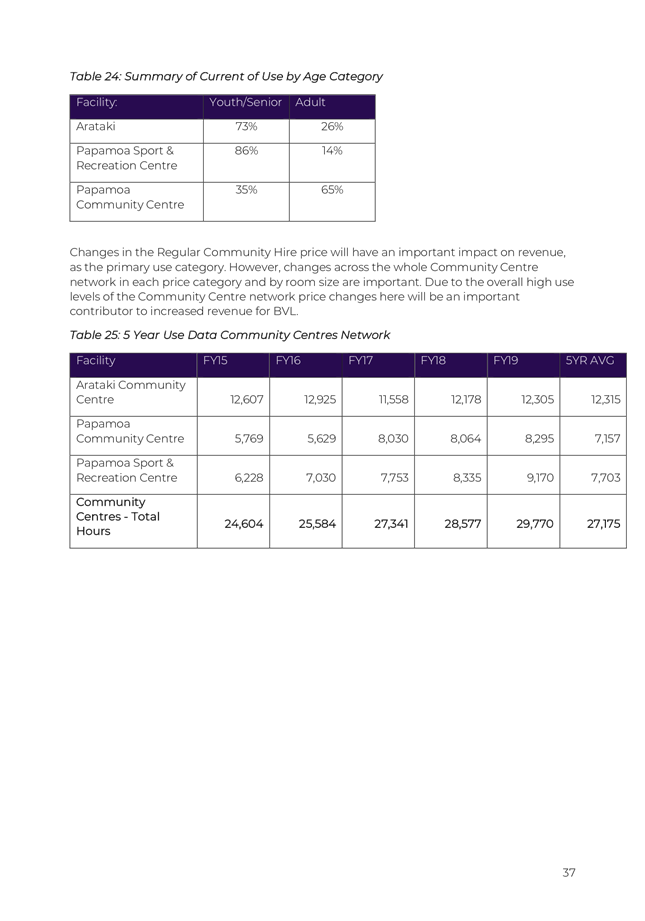
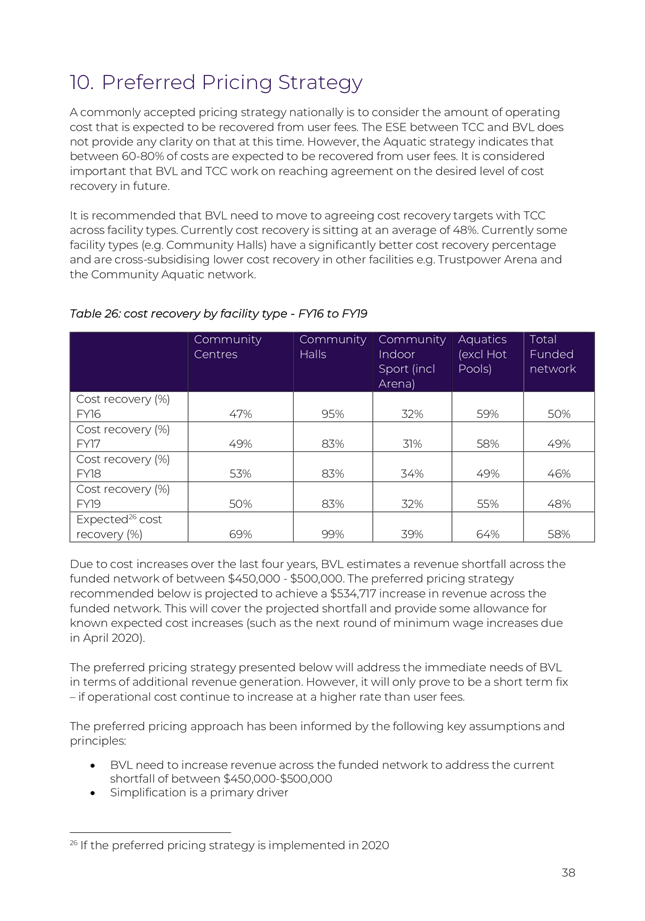
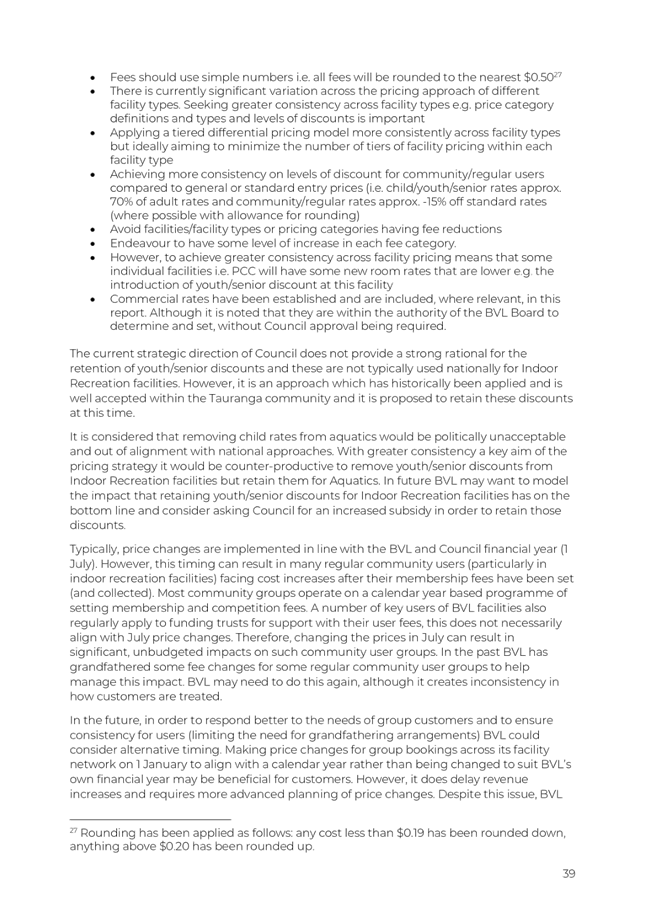


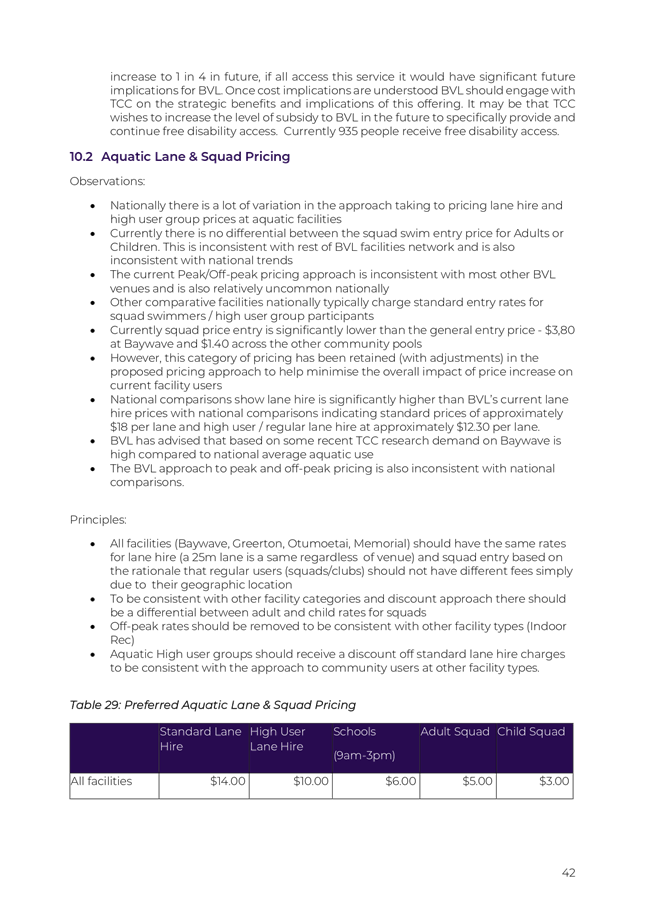

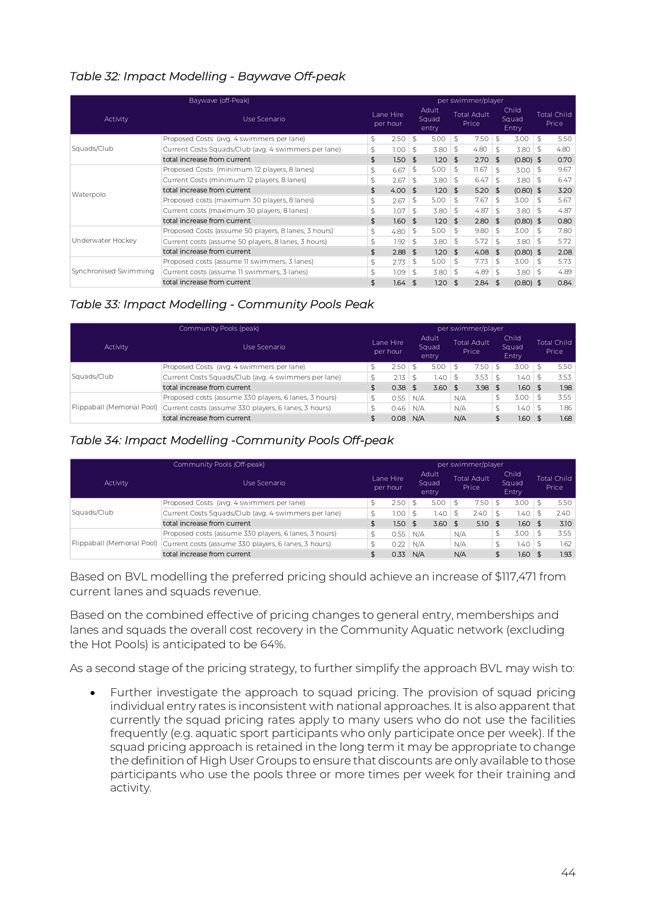




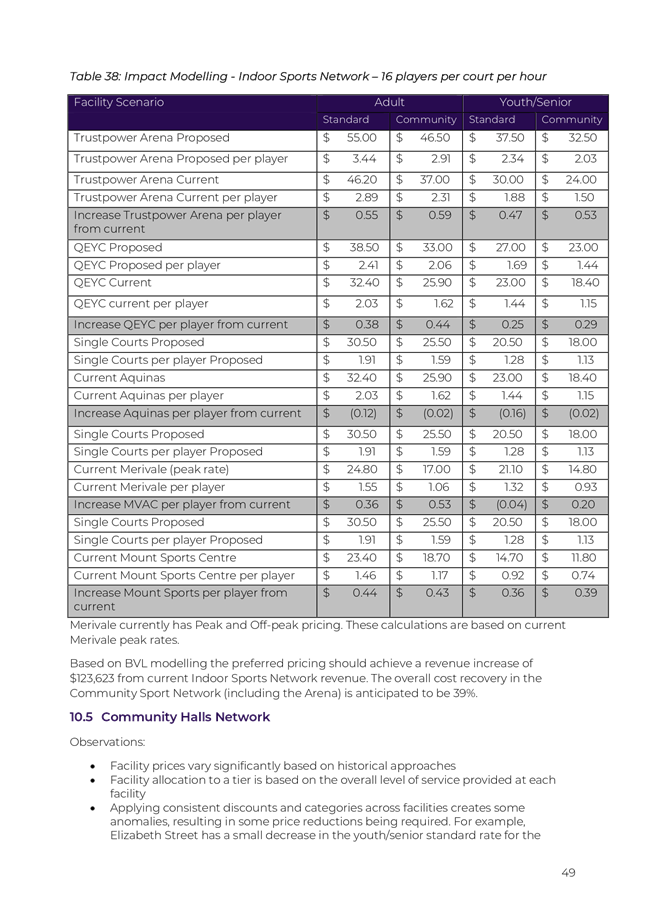

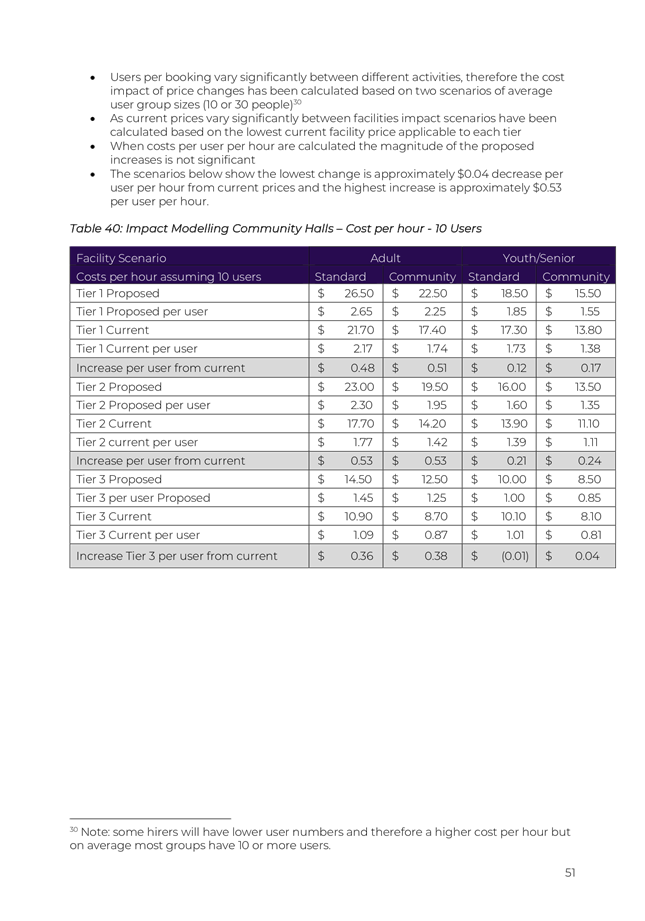



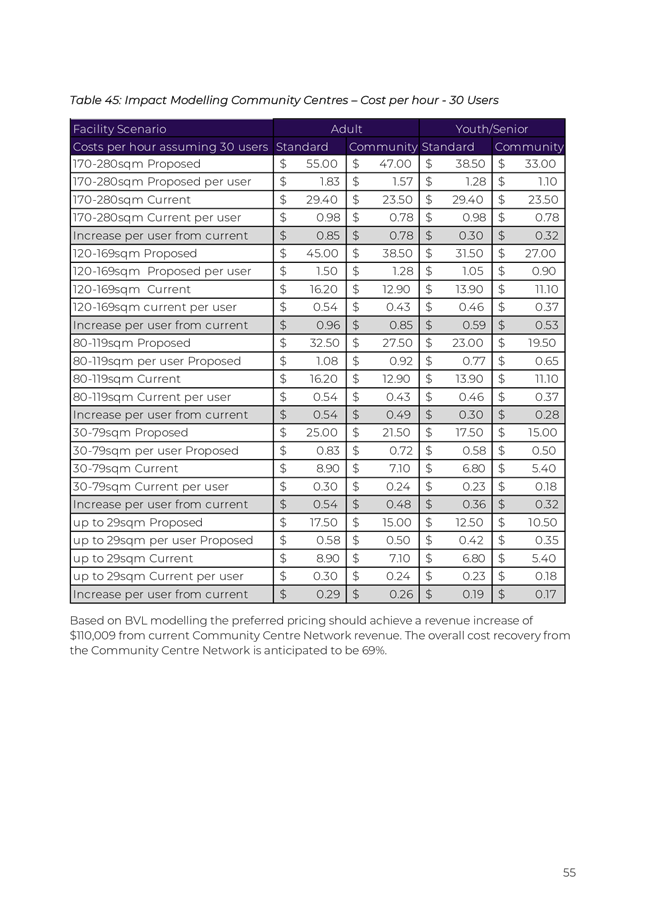

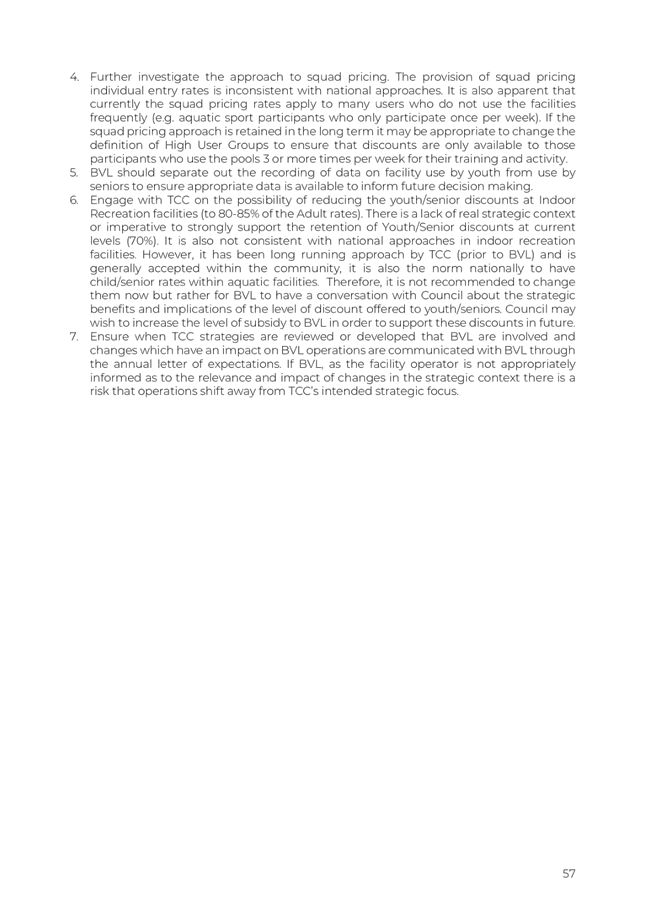







|
Policy Committee Meeting Agenda
|
19 February
2020
|

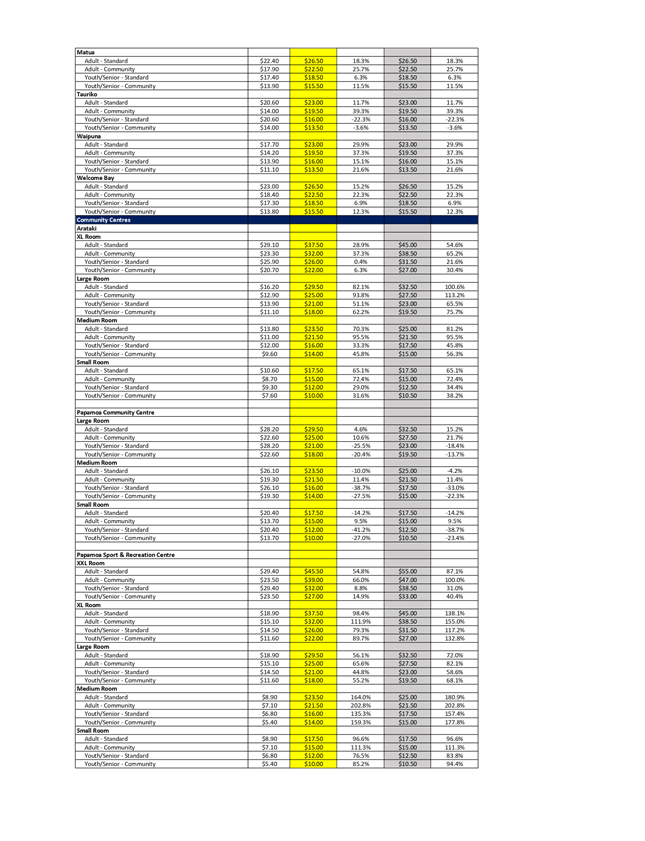
|
Policy Committee Meeting Agenda
|
19 February
2020
|
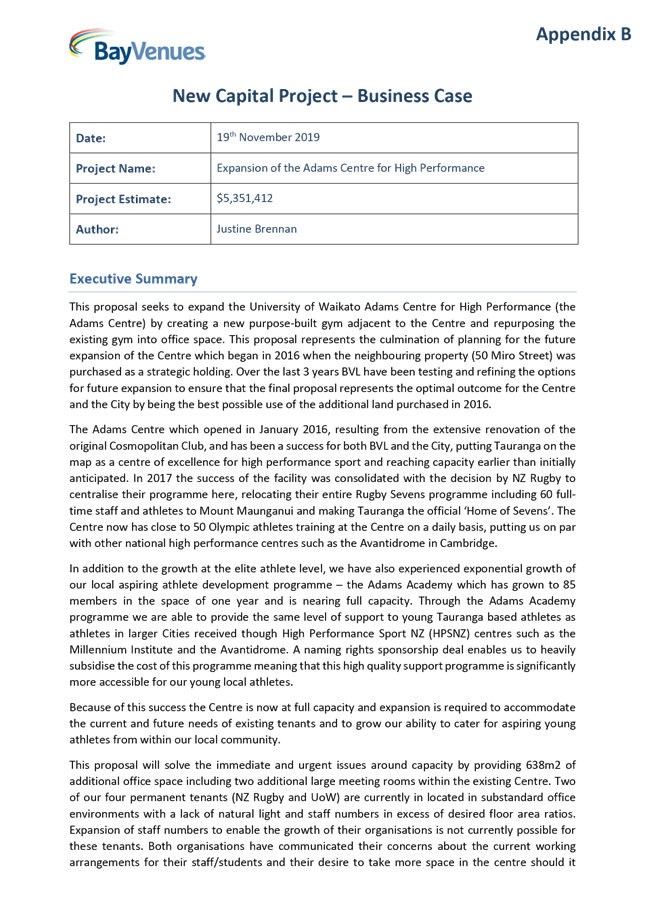
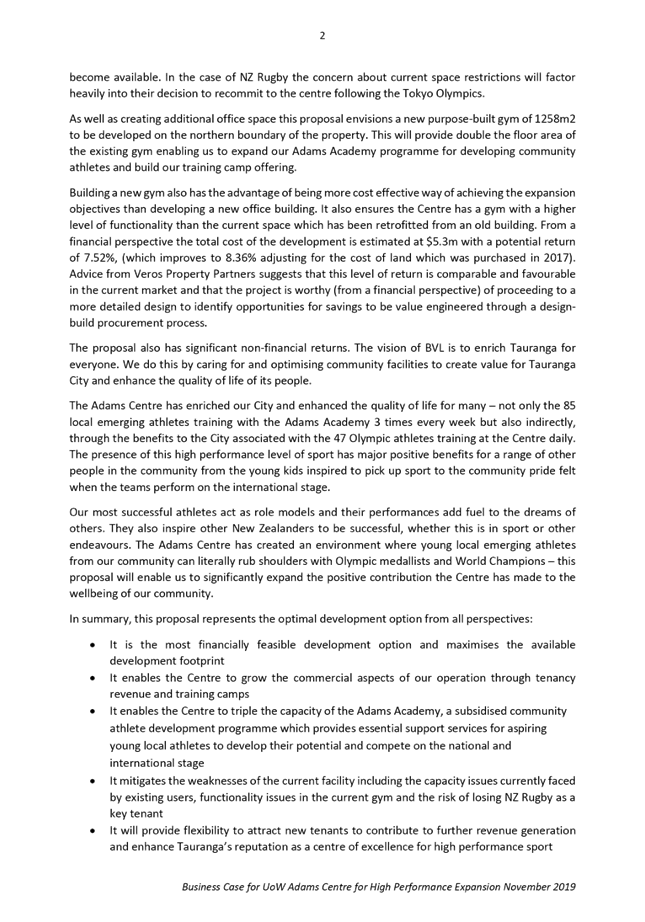




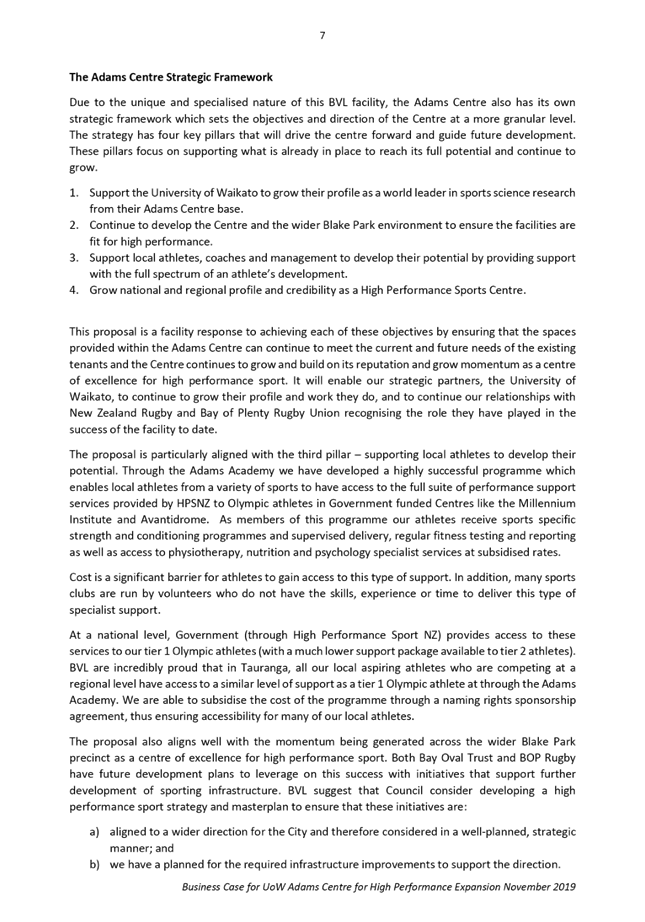

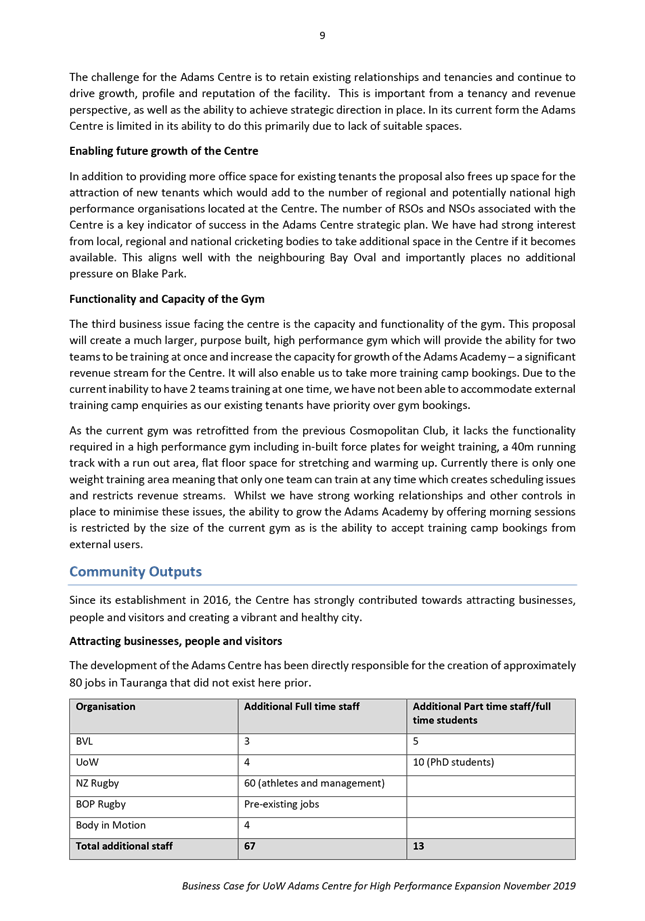
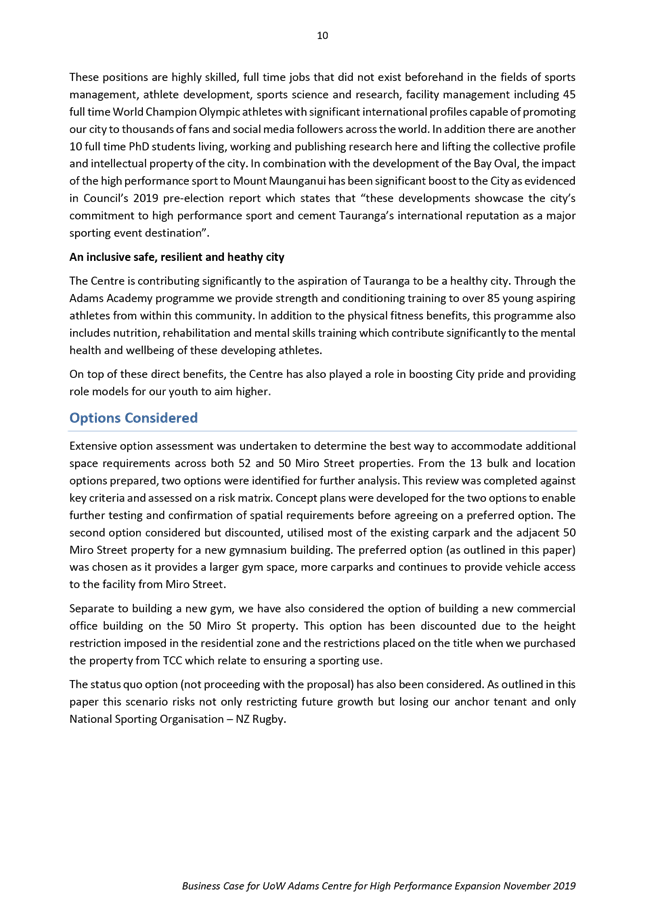

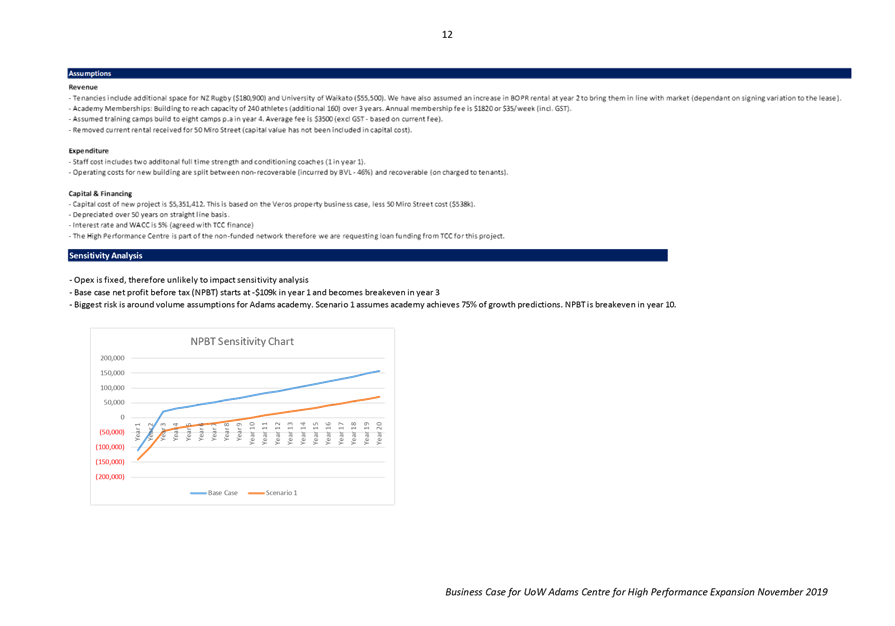

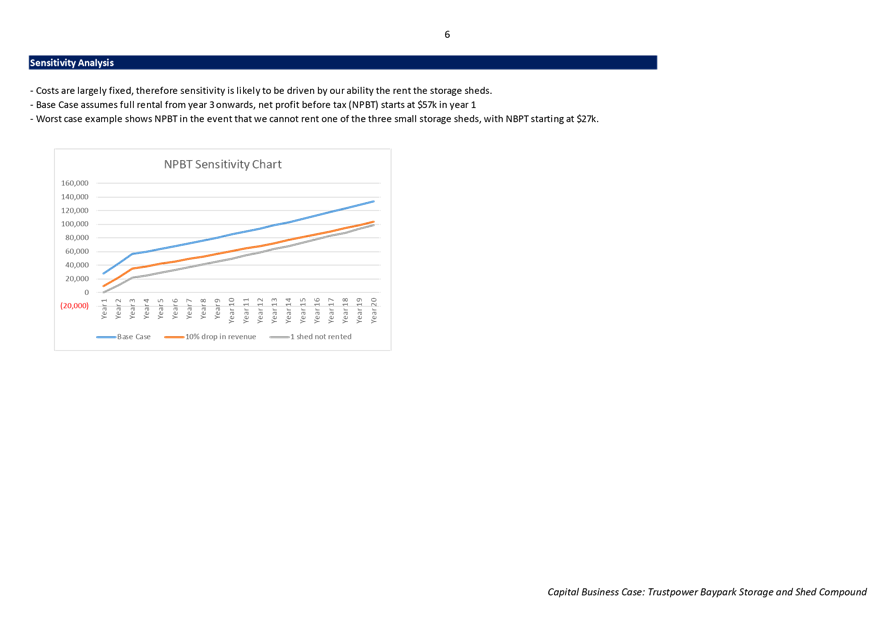






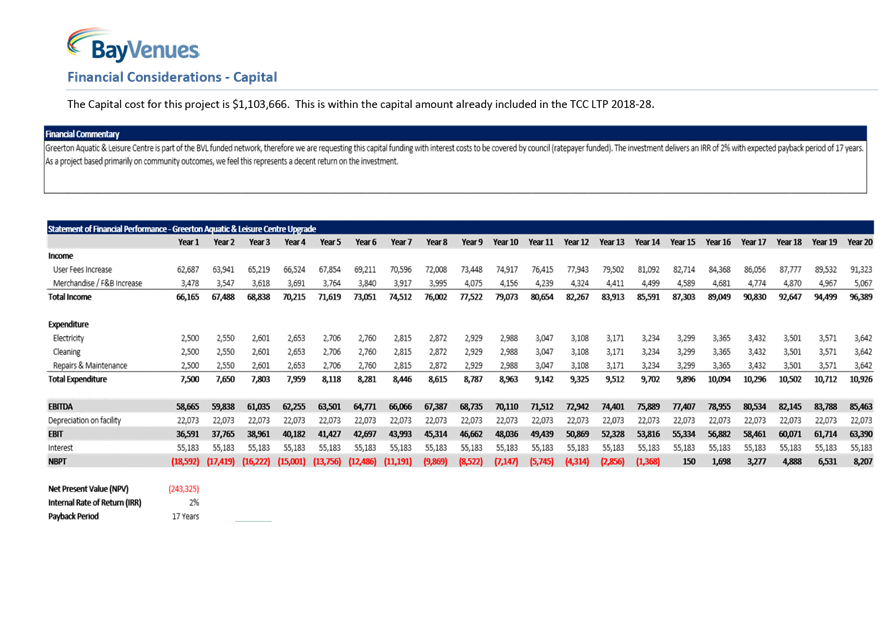

7.2 Annual
Plan 2020/21 Update
File Number: A11114461
Author: Joel Peters, Corporate Planner
Tracey
Hughes, Financial Insights & Reporting Manager
Authoriser: Paul Davidson, General Manager: Corporate Services
Purpose of the Report
1. To seek direction/approval of requests that
affect the Annual Plan 2020/21 draft budget and provide an update on the
development of the annual plan.
|
Recommendations
That the Policy
Committee:
(a) Receives the report.
(b) Approves the inclusion in the capital
programme prioritisation expenditure to:
(i) increase the capacity of the
Oropi water treatment plant ($2.6 million 2020/21 and $4.4 million 2021/22),
(ii) construct
an offloading wharf at the Marine Precinct ($1.4 million).
(c) Approves a continuation of funding for
Destination Management from the Airport Activity surplus.
(d) Notes additional requests for funding
are being prepared for:
(i) Tauranga Art Gallery
(ii) Future engagement costs
|
Executive Summary
2. In accordance with the Local Government Act
2002, Council is required to produce and adopt an annual plan, by 30 June 2020.
3. Since December several changes have meant
council is required to take on significantly more debt in 2020/21. This
has flow on effects to the capital programme. Essentially, council will
not be able to deliver all the 2020/21 capital programme and will need to
undertake some prioritisation.
4. Staff are working on these matters and will
bring a paper to the Policy Committee, for decision, in early March.
5. There are also
several items not currently confirmed/included in the annual plan budget
calculations for information/decision:
(a) additional funding to increase the
capacity of the Oropi water treatment plant
(b) additional funding to construct an
offloading wharf at the Marine Precinct.
(c) continuation of funding for Destination
Management from the Airport activity surplus
(d) additional funding for Tauranga Art
Gallery exhibitions
(e) additional funding for engagement
(f) Bay Venues Ltd funding request
(separate report on this agenda)
Background
6. On 10 December, staff presented the Annual Plan
2020/21 indicative budget for Council’s consideration. Staff recommended
that Council:
(a) Agrees to continue with year three of
the rating structure changes to reduce the UAGC to 15% and increase the
commercial differential to 1.2%.
(b) Endorses in principle the Annual Plan
draft budget for capital and operations as summarised in attachments 1, 2, and
3.
(c) In respect of the risk reserve:
(i) Notes that the draft annual plan
endorsed in resolution (b) above includes $1 million increase to the risk
reserve; or
(ii) Approves an increase to the
contribution to the risk reserve from $1 million to 4.4 million to begin to
address the current risk reserve deficit of $15 million and to recognise the
likely ongoing calls on the risk reserve.
(d) Notes that prior to finalising the draft
budget a further budget report will be provided to the Policy Committee in
February regarding:
(i) requests from Bay Venues Ltd; and
(ii) any budget updates that might arise
from work currently underway.
7. Council agreed to continue with rating
structure changes and amended recommendation (b). Council endorsed, in
principle, the Annual Plan draft budget for capital and
operations within the envelope of a mean residential rates increase for 2020/21
of no more than forecast inflation plus 2% (3.9%) and Council to be
provided with options to achieve this rating level, together with the pros and
cons of these options.
8. Council did not decide on the risk reserve and
noted the further requests and updates to come in February.
Strategic / Statutory
Context
9. In accordance with the Local Government Act
2002 (LGA), Council is required to produce and adopt an annual plan, by 30 June
2020. The purpose is to identify variations from the financial statements of
the third year of the current LTP.
10. Council must consult on changes that are significantly or
materially different from the LTP.
Current situation
11. Since the December Council meeting several updates have
occurred, which have implications for the 2020/21 budget, most significantly:
(a) The cost to deliver the Waiari water
supply project has increased impacting the 2020/21 budget.
(b) Weathertight claims have been reviewed
and have increased potential costs to council. Accordingly, staff are
recommending adding extra provision for claims in the 2020/21 budget.
12. A key financial limit for council is its debt to revenue
ratio. The limit through the LTP, and from the Local Government Funding Agency,
is a debt to revenue ratio of 250%.
13. The updates since December mean that the forecast debt
based on the current capital programme would be close to or exceed the 250%
limit. As a result, council will need to review operational and capital
budgets.
14. Staff are currently identifying what part of the capital
programme is committed in 2020/21 and what could be prioritised. A summary of
this work will be included in a report to this committee on 4 March.
15. The 4 March report will also include options and
implications for the 2020/21 budget including the option of a 3.9% mean
residential rates increase as requested in December.
16. There are also several items not currently
confirmed/included in the annual plan budget.
(a) There are four options presented for
your decision:
(i) funding to increase the capacity
of the Oropi water treatment plant
(ii) additional $1.4m to construct an
offloading wharf at the Marine Precinct.
(iii) funding Destination Management from
the Airport Activity surplus
(iv) Bay Venues Ltd funding request (separate
report on this agenda)
(b) There are also several costs/requests
that staff are aware of but require further information in advance of a
decision.
(i) Tauranga Art Gallery additional
exhibitions grant
(ii) future engagement costs
Options
Option 1: Approve funding to increase the
capacity of the Oropi water treatment plant for consideration in the capital
programme.
17. Council’s existing water treatment supply capacity
is being challenged as a result of several factors including:
(a) The Waiāri Water Treatment Plant
commissioning is likely to be delayed to the first half of 2022 therefore the
peak summer water demand for 2020/21 and 2021/22 will need to be met with
existing infrastructure.
(b) The current peak summer water demands
are higher than planning predictions and existing water treatment plants,
particularly Joyce Road, do not have the capacity to meet the future forecast
peak summer demands.
(c) The water network has pinch points and
is currently struggling to deliver the peak summer demands across the city
prior to the Waiāri being delivered.
(d) The current water demand from growth is
almost exclusively being applied to the Joyce Road plant.
18. Budgets of $2.6m in 2020/21 and $4.4m in 2021/22 are
requested for a project to increase water supply through the Oropi plant to
meet growth requirements.
19. This capital project will be considered alongside existing
capital projects for prioritisation on 4 March.
|
Advantages
|
Disadvantages
|
|
· This will provide for the peak summer demand of both 2020/21 and
2021/22.
· This option will improve the overall water supply into the City
prior to Waiāri water treatment plant coming on line.
· The increased capacity will service projected population growth in
advance of the Waiari project coming online.
· This option will also serve to provide water supply resilience
into the future.
|
· Staff and Council will need to prioritise the
capital programme, this adds to the projects in that process.
· Potential $2.6m impact on the 2020/21 capital
programme.
· If prioritised, an additional $4.4m in 2021/22 would
be required.
|
Option 2: Approve an additional $1.4m to
construct an offloading wharf at the Marine Precinct for consideration in the
capital programme.
20. $600,000 was included in the current financial year to
construct an offloading wharf for users of the marine facility. Through
engagement, users of the facility including the independent fishing fleet, have
identified the planned wharf will not be fit for purpose.
21. Staff are investigating a new concept which will provide
greater capacity for all users. Preliminary engagement with users and has been
received positively.
22. Whilst it is still in preliminary design, high level
estimates indicate that the facility would be costed at approximately $2m net
(private portions of the wharf would be paid for by those with exclusive
use).
23. This project would be undertaken in 2020/21, therefore the
budget to support this would be a $600,000 carry forward from 2019/20 and an
additional $1.4m not currently in the capital programme.
24. Detailed design and an updated business case will be
available prior to the adoption of the final annual plan in June.
25. This capital project would be considered alongside
existing capital projects for prioritisation.
|
Advantages
|
Disadvantages
|
|
· Increase the capacity of the fishing fleet in line with the
original intention of the project, to provide fit for purpose user
facilities.
· Better supports the objectives of the wharf users.
· No rating impact (subject to final business case)
|
· Staff and Council will need to prioritise the
capital programme, this adds to the projects in that process.
· Additional $1.4m debt required (non rate funded)
|
Option 3: Continue to fund Destination
Management from the Airport Activity surplus
26. Through the LTP, Council approved $621,000 of investment
per annuum to Tourism Bay of Plenty for destination management from the airport
activity. This funding was to revert to Economic Development targeted rate
funding from 2019/20 unless alternatives were found.
27. Through the Annual Plan 2019/20, Council endorsed that
Tourism Destination Management should continue to be funded through the airport
activity surplus to ensure no significant change to rating structures.
28. Staff recommend continuing to fund this investment into
destination management from the Airport activity in 2020/21.
29. Targeted rate funding or alternatives can be investigated
through the LTP process.
30. Note; Staff have already included this in the 2020/21
budget presented to you in December.
|
Advantages
|
Disadvantages
|
|
· This option will continue to support destination management.
· Funding through the airport will not have an impact on overall
rates.
|
· Debt will be higher by this amount
|
Upcoming Requests
Tauranga Art Gallery
31. The Tauranga Art Gallery is seeking funding for an
additional $259,000 grant for exhibitions which would go primarily towards
Tauranga Moana 2020.
32. A business case supporting this request will be presented
to you for consideration in March.
Future Engagement
Costs
33. Since the adoption of the LTP, Council has committed to
implementing consistent and fit for purpose engagement planning for all
projects.
34. At the time of this report a shortlist of more than 50
projects requiring engagement support over the next 12-24 months has been
developed for prioritisation with the responsible council activities.
35. The costs for engagement are likely to be highly variable
between projects and highly dependent on the level of service council seeks to
provide. These costs will be operational rather than capital.
36. As an indication, some of the potential largest engagement
projects are listed below.
· Cycle Plan
· Kerbside Collection Service Roll-out
· Long Term Plan
· Stormwater Improvements – flood hazard management
· Strategic Framework
· Transport Network Plan
· Transport Safety / Safer speeds and streets
· Te Maunga Wastewater Outfall
· Te Papa Peninsula Spatial Plan / City Plan Changes / Cameron Road
1. While many of these projects have their own
budget, a more ‘extensive’ engagement compared to the level currently
budgeted would likely incur significantly higher costs for the following
reasons:
· likely to run over a longer time period and include several phases
of engagement.
· Likely to involve a wider community decision-making approach.
· Incur more project manager time and administrative processes e.g.
collating and reporting outcomes data.
37. For example, the talking trash campaign was an extensive
city-wide campaign with an overall budget of approximately $135,000 (excluding
GST) for that distinct engagement period.
38. Staff are developing the level of service for engagement
and will be seeking guidance in March. Any increase in the level of service for
engagement will impact the 2020/21 budget.
Legal Implications /
Risks
39. In accordance with the LGA, council must consult with the
community if the annual plan includes significant or material differences from
the content of the LTP for the financial year to which the proposed annual plan
relates.
Consultation /
Engagement
40. Under the proposed approach, consultation on the annual
plan will occur in March and April 2020 alongside consultation on the draft
Development Contributions Policy (DC Policy) and draft Schedule of User Fees
and Charges.
41. The DC Policy and Schedule User Fees and Charges form part
of the annual plan. The draft documents have been presented to you as separate
reports on this agenda.
Significance
42. The annual plan is likely to be of medium to high
significance to communities.
43. The decision to accept this report and the recommendations
are of medium significance as they may affect a subgroup of the community.
Next Steps
44. Staff will incorporate the decisions from this Policy
Committee agenda into the 2020/21 budget.
45. Staff will bring a report to the 4 March Policy Committee
which will provide you with options and implications for the 2020/21 budget
including a 3.9% mean residential rates increase as resolved in December.
46. Staff will also present a consultation plan alongside the
updated budget.
Attachments
Nil
7.3 Draft
Fees for the 2020/21 Development Contributions Policy
File
Number: A11176342
Author: Ana
Blackwood, Development Contributions Policy Analyst
Authoriser: Christine
Jones, General Manager: Strategy & Growth
Purpose of the Report
1. The purpose of this
report is to provide an overview of the key changes that will be made to the
2020/21 Development Contributions Policy compared to the operative Development
Contributions Policy. A draft 2020/21 Development Contributions Policy will be
brought to Council to adopt for public consultation in March.
|
Recommendations
That the Policy Committee:
(a) Notes the contents of the
report and the expected changes to Development Contribution policy
which will be consulted on through the Draft 2020/21 Development Contribution
Policy
(b) Notes that staff will be
engaging with the building community with the purpose of providing early
notice of a signficant increase to the Citywide Development Contribution levy
in the 2021/22 financial year.
|
DISCUSSION
2. Tauranga City
Council has elected to use Development Contributions (“DCs”) as the
primary mechanism to fund growth related capital expenditure. The Development
Contributions Policy (“DC Policy”) is updated on an annual basis. The
new policy must be adopted by June to enable Council to continue collecting
Development Contributions in 2020/21.
3. The rationale
behind DCs is the growth pays for growth principle. The goal is to ascribe
costs of growth back to the development community to reduce the burden of these
costs on the existing rate payer community.
4. Use of DCs is
governed by legislation set out in the Local Government Act 2002 (LGA).
5. Sections 2-5 of the
DC Policy set out the rules for when a DC is charged, and the methodology used
by TCC for calculating development contributions. These sections are not
expected to change compared to the operative policy.
6. Section 1 contains
the fees applicable to development and these will be updated to reflect changes
made to capital expenditure budgets. Section 6 contains the Schedules of assets
(tables) which show detailed costing information for each asset for which
council collects development contributions. These tables have been updated to
reflect budgets set out in the annual plan documents.
7. Development
contribution fees are broken into two types, local development contributions
and citywide development contributions. These are discussed separately below.
Local
development contributions
8. Local development
contributions (“LDCs”) are usually payable when land development
occurs (i.e. subdivision). LDCs fund infrastructure within specific catchments
and the amount payable varies with location. The following table sets out the
LDCs that are expected to be included in the Draft 2020/21 DC Policy and comparisons
to fees in the operative policy.
|
Draft fees
|
|
Movement compared to
operative policy
|
|
Fee increases
|
|
West Bethlehem
|
$ 372,880
|
Per hectare
|
+
5.0%
|
+$17,400
|
|
Tauranga
|
$ 3,614
|
Per additional lot
|
+ 1.3
%
|
+ $46
|
|
Pyes Pa
|
$ 6,802
|
Per additional lot
|
+ 0.8
%
|
+ $ 51
|
|
Papamoa
|
$ 8,701
|
Per additional lot
|
+ 0.3
%
|
+ $ 27
|
|
Welcome Bay
|
$ 8,480
|
Per additional lot
|
+
0.3%
|
+ $ 23
|
|
Bethlehem
|
$ 12,516
|
Per additional lot
|
+ 0.2 %
|
+ $ 21
|
|
Fee decreases
|
|
Pyes Pa West
|
$ 29,752
|
Per additional lot
|
- 3.3 %
|
-$1,000
|
|
Wairakei
|
A: $480,124
B: $329,847
C: $648,053
|
Per hectare
|
- 0.6 %
- 0.6 %
- 3.0 %
|
-$3,096
-$1,830
-$19,917
|
|
Tauriko
|
$ 352,404
|
Per hectare
|
- 2.0 %
|
-$7,355
|
|
Ohauiti
|
$11,272
|
Per additional lot
|
- 0.5 %
|
-$61.46
|
9. As shown in the
above table, the fees for West Bethlehem will increase by 5%. This increase is
because LDCs in this catchment are subsidised by Council and the level of the
subsidy decreases each financial year. As the subsidy decreases the fees go up.
10. The West Bethlehem subsidy is
the result of previous Council decisions. Without the subsidy the LDC was so
high that it was inhibiting growth in the area and limiting TCC’s ability
to recover debt incurred in constructed infrastructure.
11. Other
fee increases are only minimal amounts and are the result of updated capital
expenditure budgets.
12. Fees for Wairakei, Tauriko,
Pyes Pa West and Ohauiti are decreasing. These decreases are because NZTA funds
have been apportioned towards specific projects in these catchments. Money received
from NZTA decreases the proportion that needs to be recovered as development
contributions.
13. While the charges for Wairakei
are decreasing overall it is important to note that there has been an increase
in the wastewater fees of approximately 111%, from $22,600 per hectare to
$48,000 per hectare.
14. The wastewater increases are
primarily driven by increased costs of the Opal Drive and Wairakei Trunk
networks. Budgets for these projects were reviewed to provide for needs
identified in the review of strategic wastewater projects in the eastern
corridor.
15. The review considered the
constraints, future needs, and ground conditions of the area to provide for
future populations and resilience. The review identified new design
requirements and provided a greater understanding of constraints and risk to be
managed throughout construction.
Citywide Fees
16. Citywide development
contributions (“CDCs”) are applied to building consents for growth
developments such as new houses or new commercial buildings. CDCs are due
payable immediately prior to the issue of the building consent.
|
|
Current 2019/20 Citywide
charge
|
Projected 2020/21 Citywide
charge
|
Movement
|
|
|
Charge per household
|
$ 8,530
|
$9,380
|
+10%
|
|
|
|
|
|
|
17. The CDC is currently just over
$8,500 per household. As shown in the above table, this is expected to increase
by 10% in 2021. This increase is driven by increased cost to construct the Te
Maunga Wastewater Treatment Plant. The two main reasons for this cost
escalation are:
(a) Increased preliminary &
general costs and contractor profit. The national trend has been going upward
the last couple of years.
(b) Large increase due to poor
ground conditions and requirement for additional subfloor ground support for
the bioreactor.
18. In the 2022 financial year the
CDC is expected to increase by an even greater margin. The exact increase
cannot be determined until project costs are finalised, but projections show it
is likely to be in the order of $5,000 - $9,000 more than the 2021 charge. This
means that the CDC could potentially double from $9,380 to $18,380 per
household.
19. The increase primarily relates
to the Waiari Water Supply Project which will be entirely funded by CDCs
collected from the 2022 year on. There are also some other smaller projects
which will be funded from 2022 year on that contribute to this increase.
20. There is already a brief
mention of this expected increase within the operative DC policy. Staff will
update and expand on this information in the 2021 DC Policy and are planning an
engagement strategy designed to highlight this information to the development
community to whom it will impact.
21. While this increase does not
technically impact the 2021 DC policy which is being consulted on in March, it
could be expected that Council may receive some feedback on this matter via
this year’s annual plan submission process.
Community
Infrastructure
22. The
review of the LGA in 2019 resulted in a broader definition
of the term ‘community infrastructure’ being adopted. Staff have identified
several community facilities projects planned in the western corridor and
Wairakei/Te Tumu catchments that were planned to be loan funded but, based on
the new definition of community infrastructure, could potentially be funded
using DCs.
23. In
order to calculate the proportion
of the projects which could be funded by DCs, we first need to
understand the rationale for the facilities, and the extent to which these
facilities benefit growth versus the benefit to existing populations. Work is
currently being undertaken on community facility needs (by Visitor Solutions)
which will help to inform this decision.
24. We cannot
start collecting DCs for any of these projects yet (as none are budgeted within
this planning period) and so staff have determined it is more appropriate to
make any updates to project funding through the LTP process when more detailed
information will be available.
25. A further report will be
brought to Council for consideration on this matter within the next few months.
Strategic / Statutory Context
26. The Local Government Act 2002
requires Council to have a Development Contributions Policy. Development
contributions are a significant and strategic revenue source for the Council
and are critical to funding capital expenditure associated with providing for
the growing city. Development contributions enable infrastructure to be
built to unlock additional development capacity.
Consultation / Engagement
27. In March 2020 a draft version
of the 2020/21 DC Policy will be brought to Council to adopt for public
consultation. This draft policy will be consulted on alongside the annual plan.
The policy will also be distributed directly to key stakeholders in the
development community.
28. Through this process the
community will have the opportunity to submit to Council on the key changes
proposed.
29. The draft policy will include
a discussion around the expected future increases to the Citywide Development
Contribution charges. Staff are also working on an engagement strategy that
will likely run in parallel to the annual plan consultation to ensure that this
future increase is highlighted to the building community whom will be impacted
by this increase.
30. While the increase is not
technically occurring in this financial year it is likely that Council will
receive feedback on this matter through the consultation process.
Significance
31. Under the Significance and Engagement Policy 2014,
this report is of low significance as it is asking Council to note the changes
that will be incorporated into the Draft 2020/21 Development Contributions Policy.
The adoption of the Draft policy itself will be of medium to high significance
and this policy will brought back to Council and will be consulted on in
accordance with requirements under the Local Government Act 2002.
Next Steps
32. Staff will finalise the
content of the Draft 2020/21 Development Contributions Policy and will bring
the Policy to Council to be adopted in March. Once adopted the Draft Policy
will be distributed for public consultation. Specific targeted consultation
will be undertaken with the development community and with the building
industry regarding the anticipated future increases to the Citywide Development
Contributions Fees.
Attachments
Nil
7.4 Draft
user fees and charges
File
Number: A11189535
Author: Tracey
Hughes, Financial Insights & Reporting Manager
Joel Peters, Corporate Planner
Kathryn Sharplin, Manager:
Finance
Authoriser: Paul
Davidson, General Manager: Corporate Services
Purpose of the Report
1. To seek your
approval of the proposed schedule of user fees and charges, for 2020/21, to be
consulted on alongside the annual plan.
|
Recommendations
That the Policy Committee:
(i) Approve
the proposed schedule of user fees and charges for 2020/21, outlined in Attachment
1, for future consultation with communities.
|
Discussion
2. User
fees and charges are one of our largest sources of revenue. They assist the
operation and maintenance of a variety of services provided to communities.
3. Each
year, we update user fees and charges to respond to economic and legislative
changes, and to ensure that charges do not become outdated.
4. We
produce and make a schedule of user fees and charges for communities to find
all fees and charges council is authorised to set under the various pieces of
legislation that we work under.
5. User
fees and charges and revenue projections have been reviewed and updated.
Updates reflect changing circumstances, amendment to descriptions to make the
document clearer for the community, Consumer Price Index (CPI) adjustments, new
or removed fee requirements, or benchmarking with other councils. Some user
fees and charges are set by government legislation.
6. Attachment
1 outlines the user fees and charges for each activity and are presented with a
comparison to the actual fees charged for the current financial year. A summary
is also included to discuss any proposed changes.
7. The
financial implications of proposed changes have been incorporated into the
draft Annual Plan 2020/21.
Summary of changes
8. Changes
to the CPI have been used as the basis for increases. Most fees and charges are
proposed to increase by 1.9% from 2019/20 (where more practical, values are
rounded).
No proposed increase
9. Some
activities have proposed not to increase most of their fees and charges via
CPI. This is due to fees having undergone a significant increase last financial
year, and/or due to the current level being appropriate and in line with the
current market, or the fees are set by legislation. They include:
(a) Airport
(b) Digital
Services
(c) Land
information fees
(d) Libraries
(e) Mount
Maunganui Beachside Holiday Park
(f) Official
information requests
Proposed changes above
CPI
Explanations
have been provided in Attachment 1 for fee increases greater than CPI.
|
Animal
Services
|
Increase
of fees by 6% to match operational costs.
Increase
of mileage reimbursement fee to reflect the current rate.
|
|
Asset
Protection Bonds and service connection fees
|
Significant
increase in service connection application fees to reflect the actual cost
processing applications.
|
|
Bay
Venues
|
Increases
subject to Council/Policy Committee decisions. Note: this is the subject of a
report to the Policy Committee
|
|
Building
services
|
Increase
to the solar installation fee to reflect an accurate cost and increase to the
environmental planning processing fee.
|
|
Laboratory
fees
|
Fees
updated to reflect new contract rates
|
|
Parking
|
Small
increase to off street parking fees which supports continued investment in
parking infrastructure and to encourage less dependency on private transport,
help manage congestion, and reduce carbon emissions. Remove early bird fees
from carpark buildings
|
|
Parks
& Recreation
|
Increase
in the fee to stay at McLaren Falls Reserve.
Increase
to the events on parks commercial fee.
|
|
Planning
|
Increase
to the hourly rate for some staff positions.
|
|
Regulation
Monitoring
|
Increase
to mobile shops fee for Marine Parade tender sites.
|
|
Sustainability
and Waste
|
Increase
in the abandoned car storage fee to reflect actual costs.
|
Proposed new fees
Some
activities have proposed new fees. They include:
|
Baycourt
|
For
clarity, a community organisation fee and a separate commercial fee are
proposed in place of a general fee and subsidised fee for community
organisations.
|
|
Building
Services
|
New fees proposed for on-site minor variations to amended plans,
Code Compliance Certificate (over 5 years old) Drainage, Solid Fuel Heaters,
Solar, Retaining Walls, Commercial Code Compliance Certificate (over 5 years
old), and CCC Reactivation Fee.
|
|
Parks
and Recreation
|
New fees
proposed for public amenities use for events on parks and to McLarens Falls
events with over 100 participants. Commercial and Not for Profit fees for
markets on public open space.
|
|
Planning
|
New fee
proposed for Environmental Monitoring Technician.
|
Next Steps
10. Should
you approve the proposed schedule of user fees and charges at Attachment 1, it
will become the basis of future consultation under a special consultative
procedure.
11. If
you propose amendments to the user fees and charges, this may result in changes
to required activity budgets.
12. We
will present a statement of proposal to the Policy Committee in March for
approval ahead of consultation.
Attachments
1. Draft
user fees and charges 2020-21 - A11189525 ⇩ 
|
Policy Committee
Meeting Agenda
|
19 February
2020
|

